
Support Team
Feedback:
support@nextpcb.comThe first-ever KiCad Conference in the east, KiCon Asia saw an eventful day packed with expert KiCad tutorials from the lead developers themselves and intriguing talks on industrial applications of KiCad including AI implementation in EDA tools and using KiCad for creating IC packages. The technical session was finished off with a Q&A session followed by a SAO hat soldering workshop.
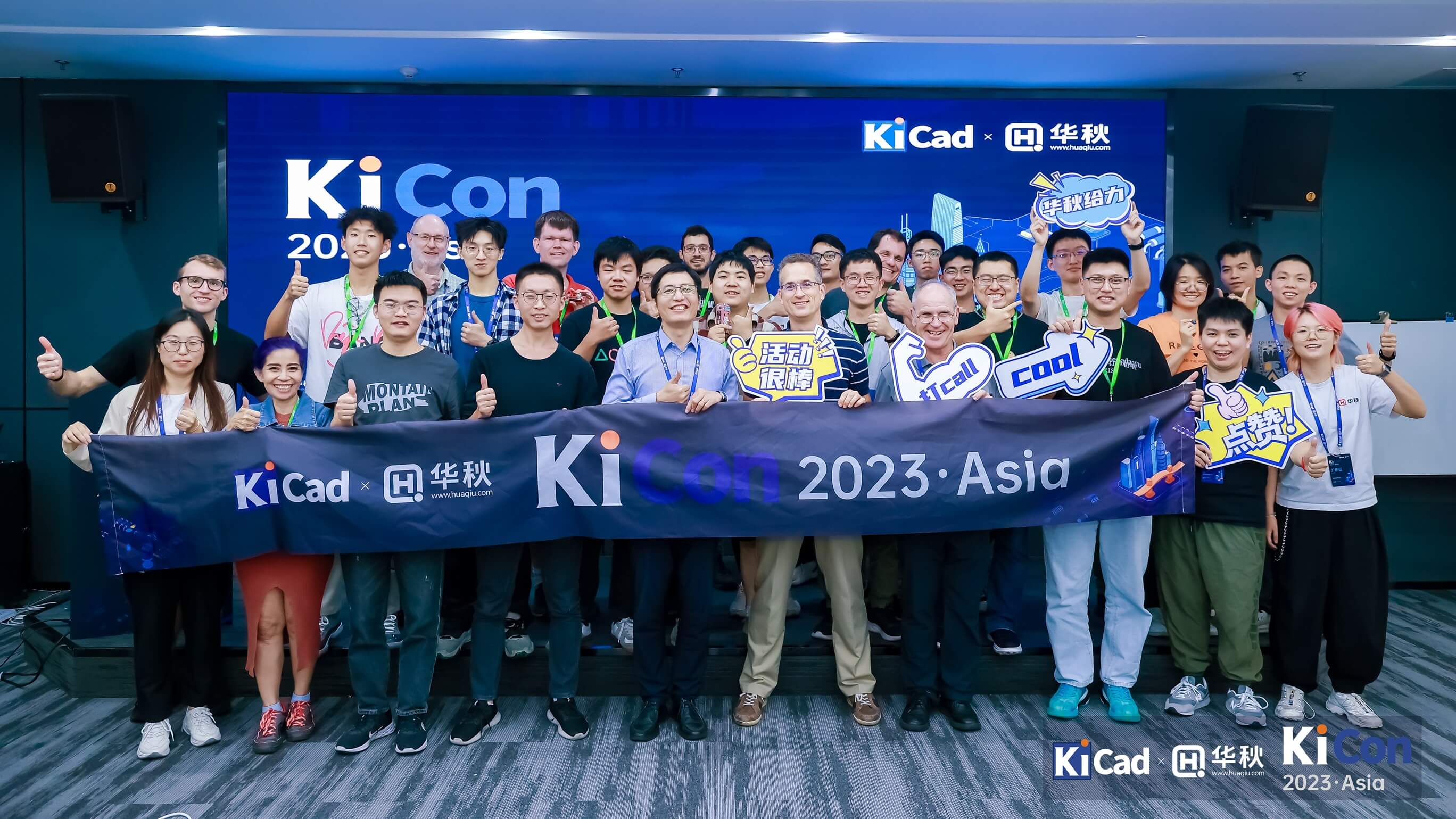
Held in Shenzhen, China, the lead KiCad developers were lured to the Far East after seeing the rapid growth of KiCad users in China in recent years. Previously, the majority of KiCad's user base was located in the US or Europe and KiCad conferences for these areas were held in previous years with great success.
With on-ground support from the main sponsors, Huaqiu Electronics, and volunteer speakers from across China, KiCon Asia 2023 was a major success and helped solidify a bright future for the open-source EDA tool in the Chinese community.
Recordings of the talks will be uploaded onto the official KiCad YouTube channel soon! Here are the highlights for the time being:
by Wayne Stambaugh
As with all previous KiCons, KiCad project lead and honored guest Wayne Stambaugh leads the talks with his project status update.
In his talk, Wayne mentions how the previous year saw a highly successful fundraising campaign raising over $200k for the KiCad project including 4 platinum sponsors, the latest addition being Huaqiu Electronics.
Wayne details all the changes made in KiCad 7 and KiCad 8, which he announced will be released on January 31st next year. KiCad 8 will see several long-awaited features being released including Altium and EasyEDA importers, simulation improvements (FFT, S-parameter, etc.), BOM functionality, Windows Arm 64 support, improvements to SVG and DXF imports and many other quality-of-life improvements.
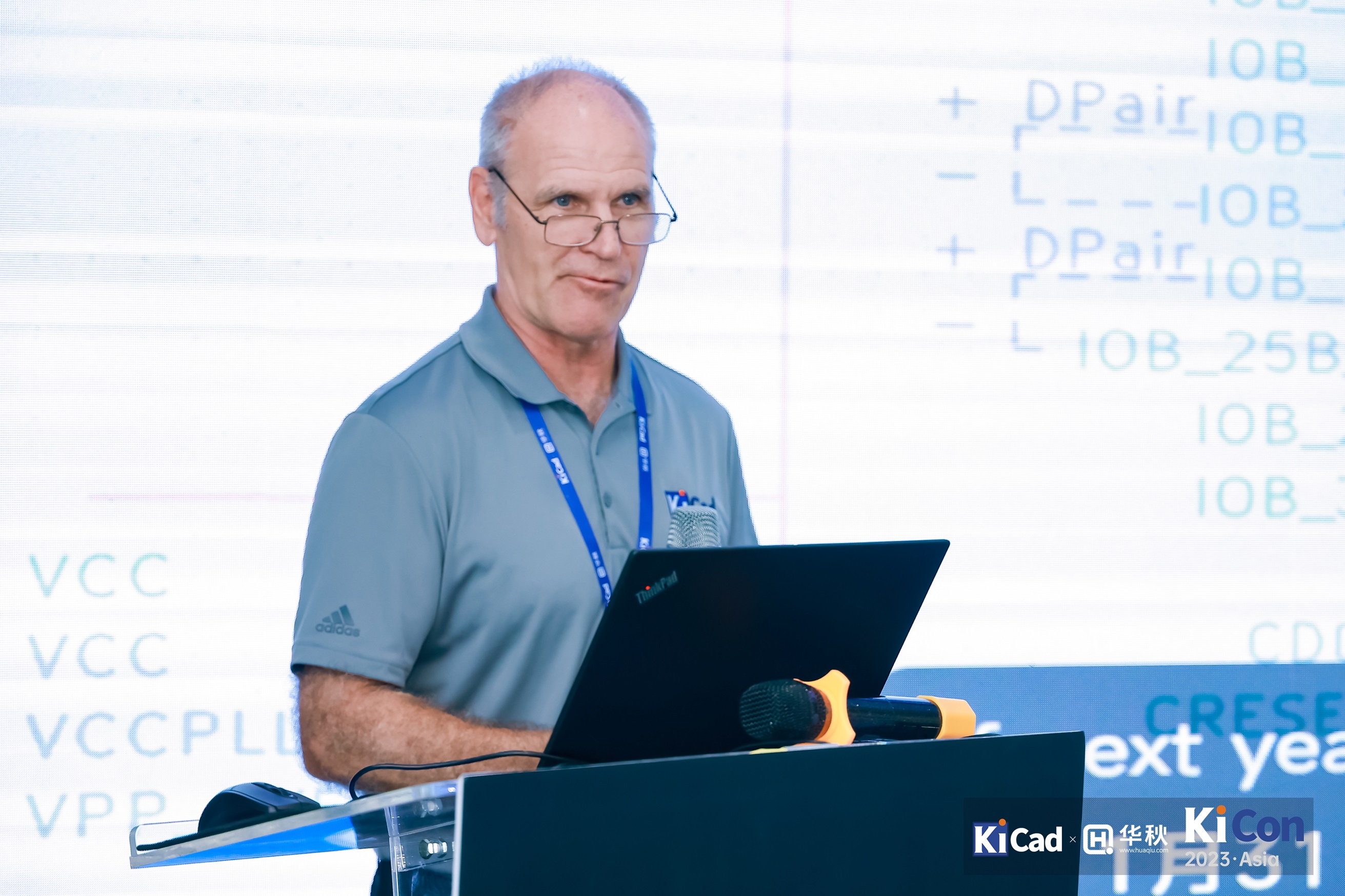
KiCon followers will notice that Wayne has added pictures and GIFs to his project status update, which makes all the difference!
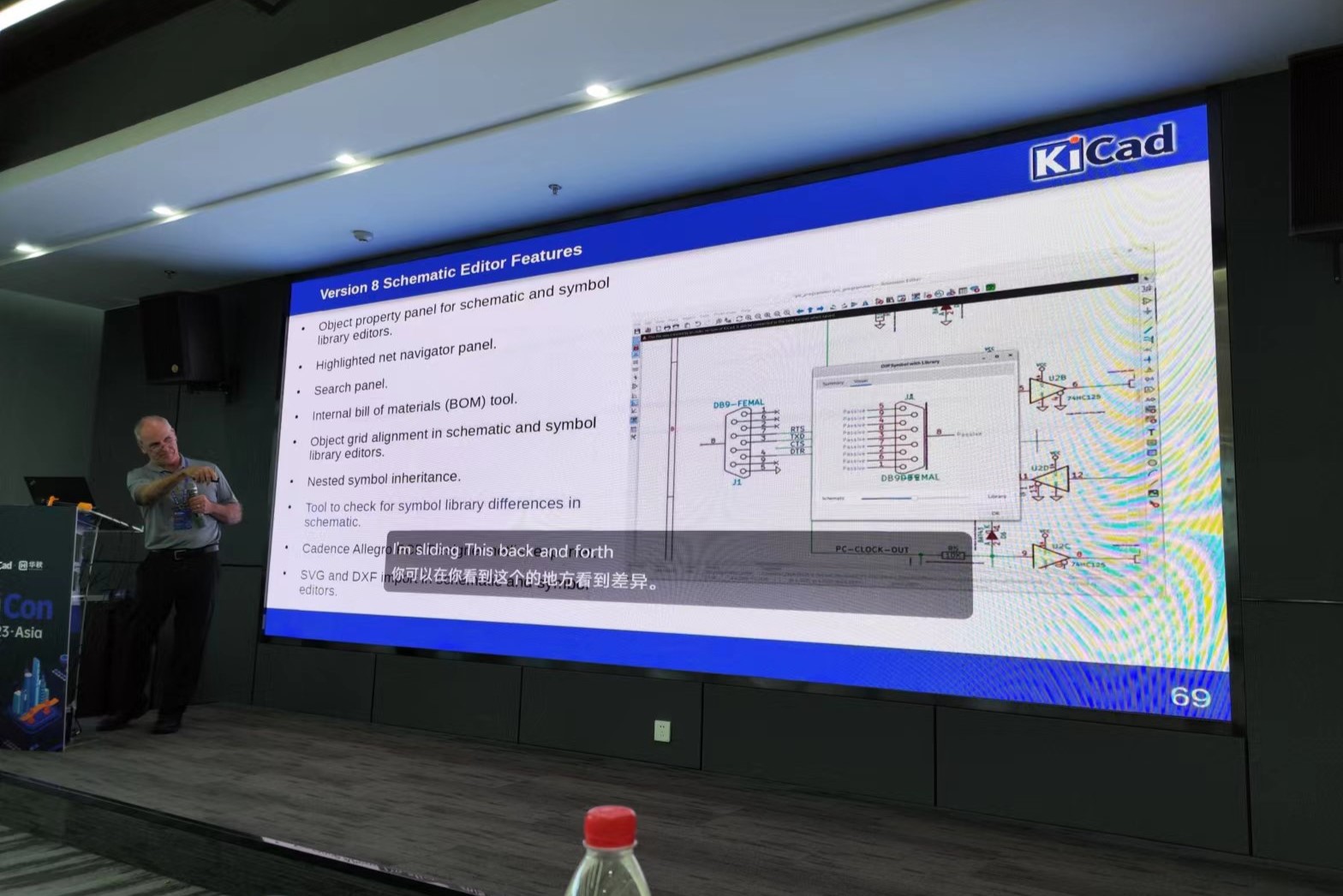
There was much interest in the graphical comparison viewers for symbols and footprints coming in KiCad 8, and whether such interfaces could be expanded to code and other interfaces.
by Seth Hillbrand
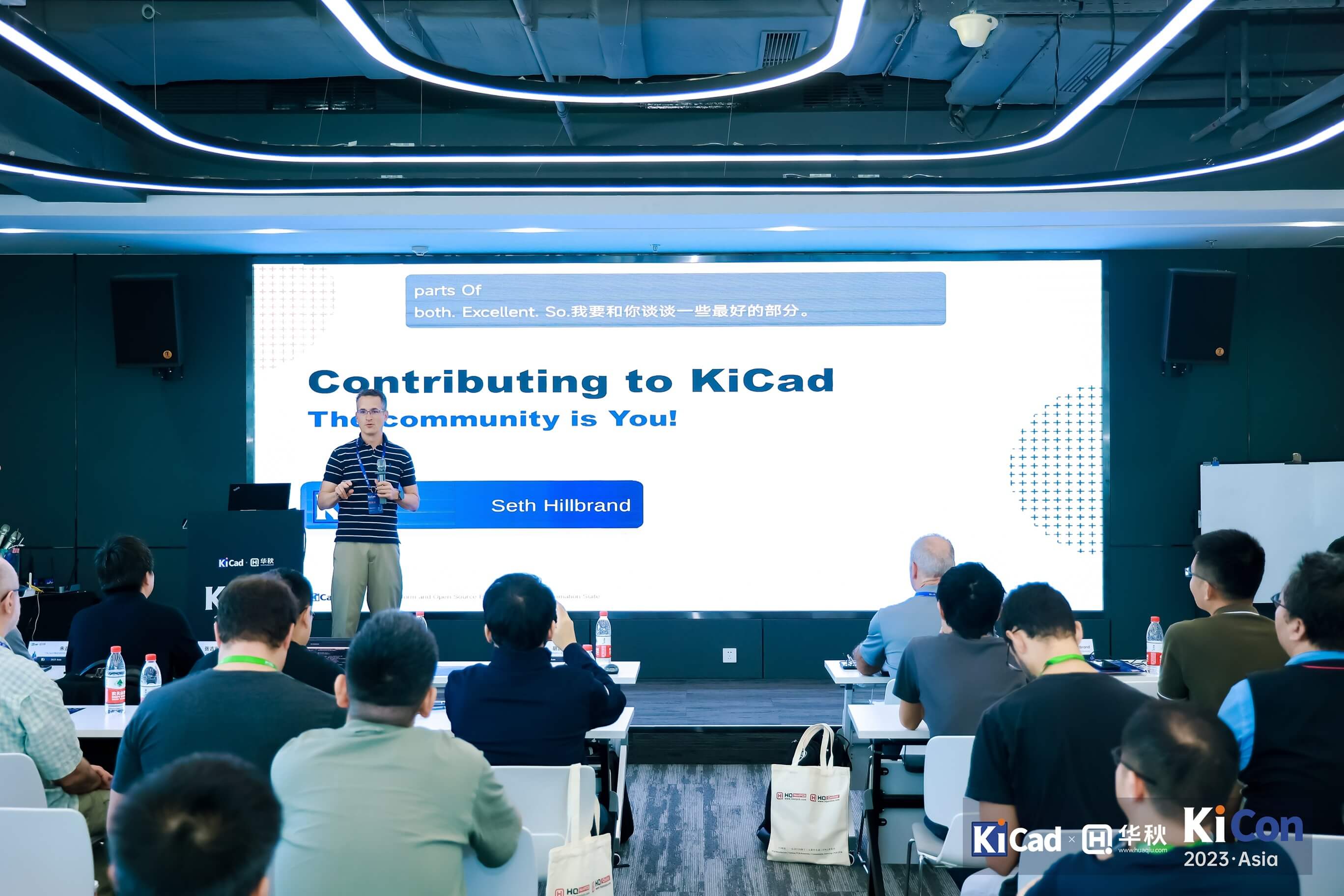
In his talk, KiCad lead developer Seth Hillbrand enthusiastically emphasizes how anybody with any skill-set, can contribute to the KiCad project and the KiCad community. In addition to donating, reporting bugs and writing code, Seth highlighted some lesser-known methods including website maintenance, answering forum questions, marketing and even writing an e-mail to say thank you to another contributor is invaluable in preserving and supporting the KiCad ecosystem.
KiCad became open source in 2007 and currently has two full-time lead developers, 9 additional lead developers and over 100 code contributors.
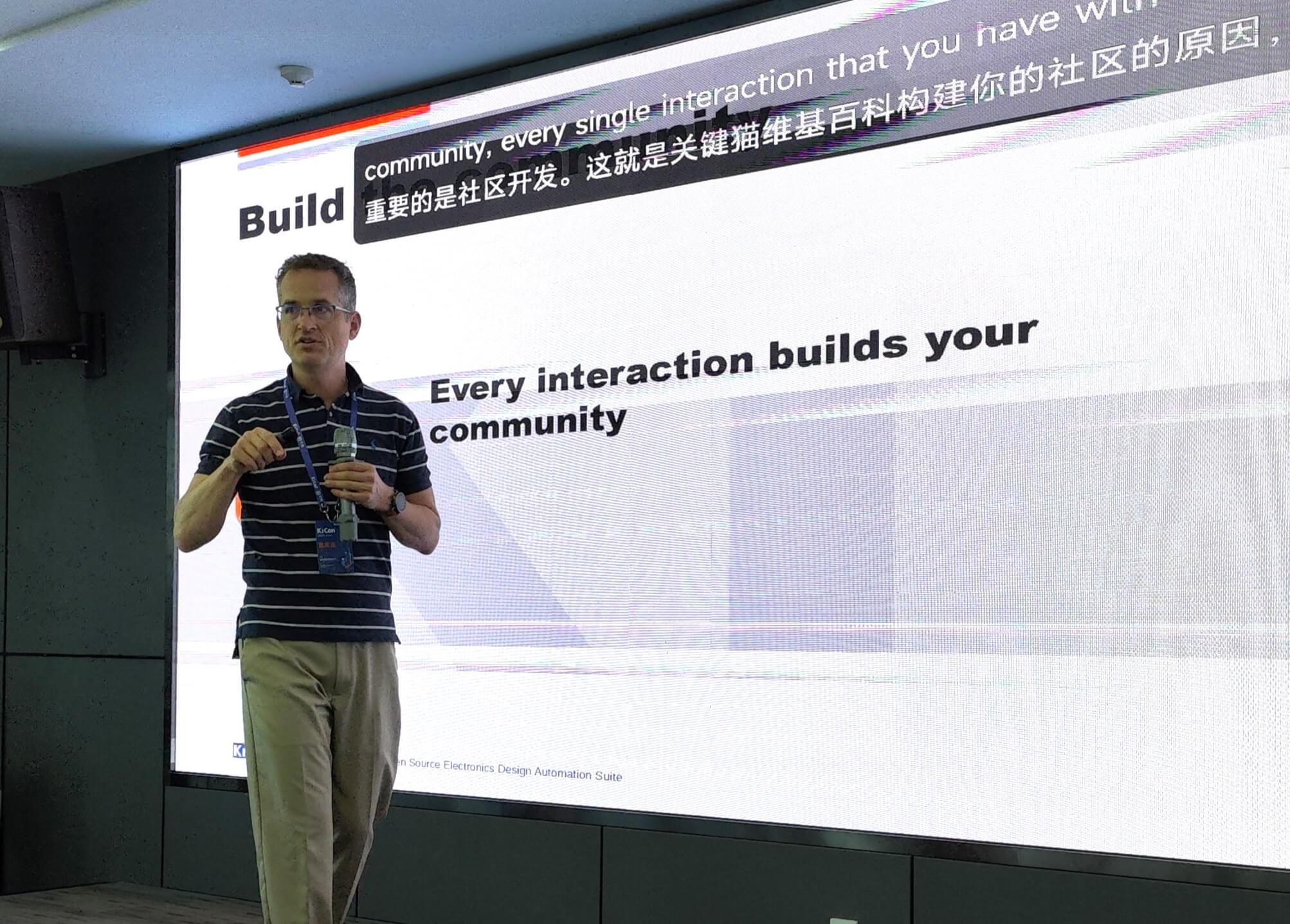
Beautifully said
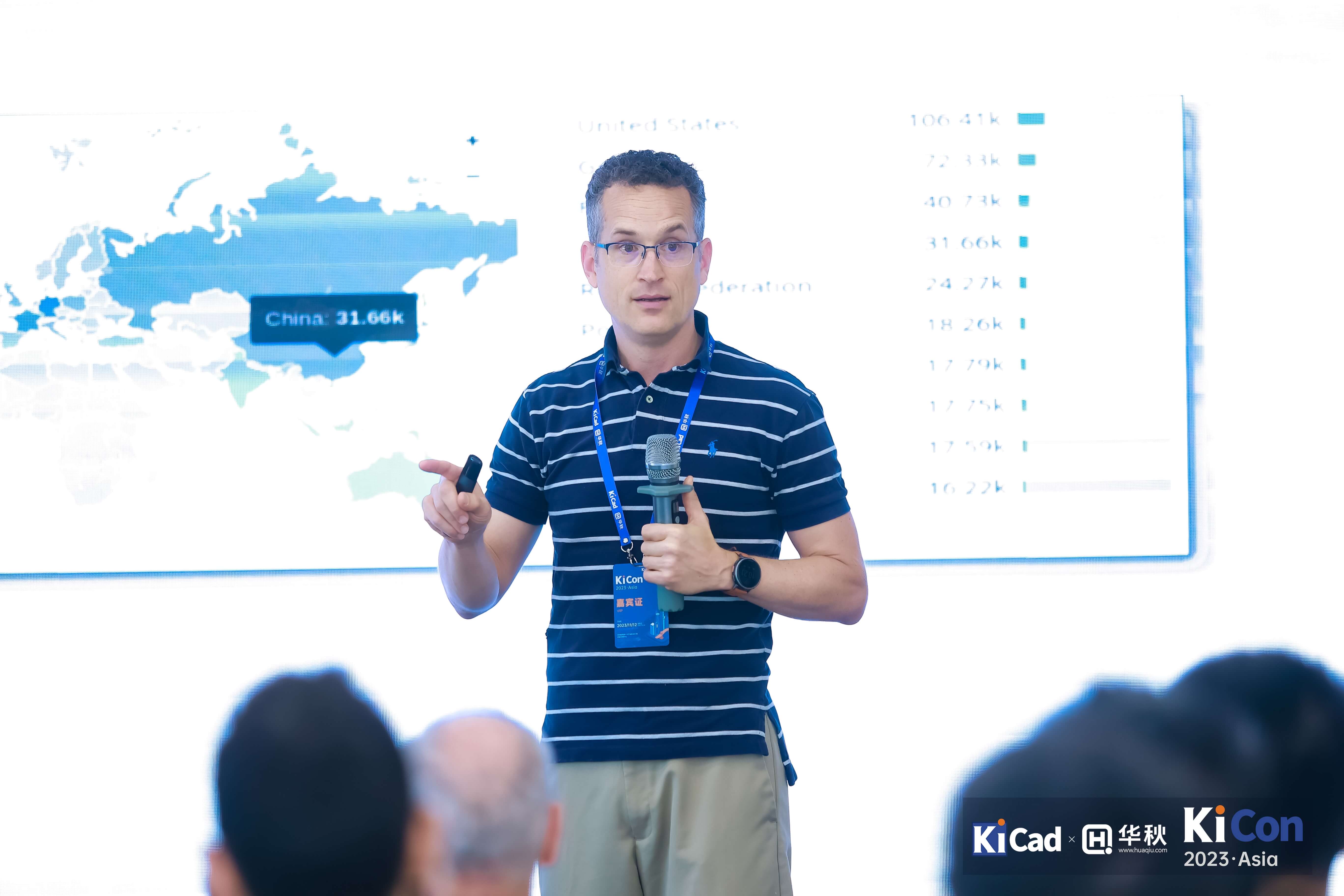
Seth also mentioned the rapid growth in Chinese KiCad users from the top 6 to the top 4 in less than two years, behind France and Germany. That’s a lot of potential contributors.
by Zhang Jixin and Yanzhen
In a change of pace, the following two talks both share research and implementations of AI for auto-routing and auto-placement, of which KiCad is used as a platform thanks to its open-sourced nature. AI is finding its way into workflows across all sectors and it is only fitting that EDA (Electronics Design Automation) tools get the AI upgrade.
The long and somewhat tedious process of routing traces and placing parts consumes a large bulk of the electrical engineer's time and energy, and so automating the process can reap large returns in terms of efficiency and see monumental changes in the industry.
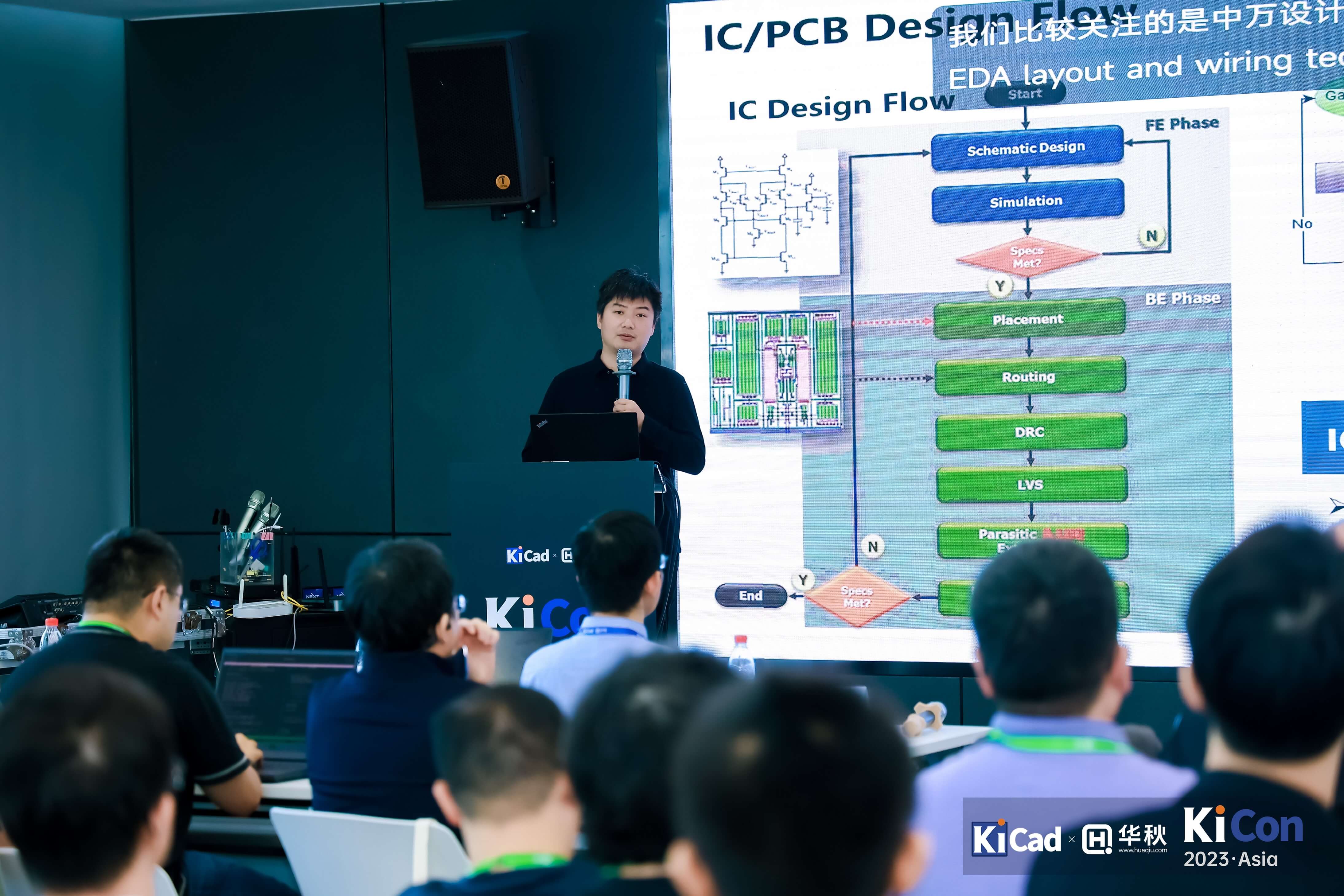
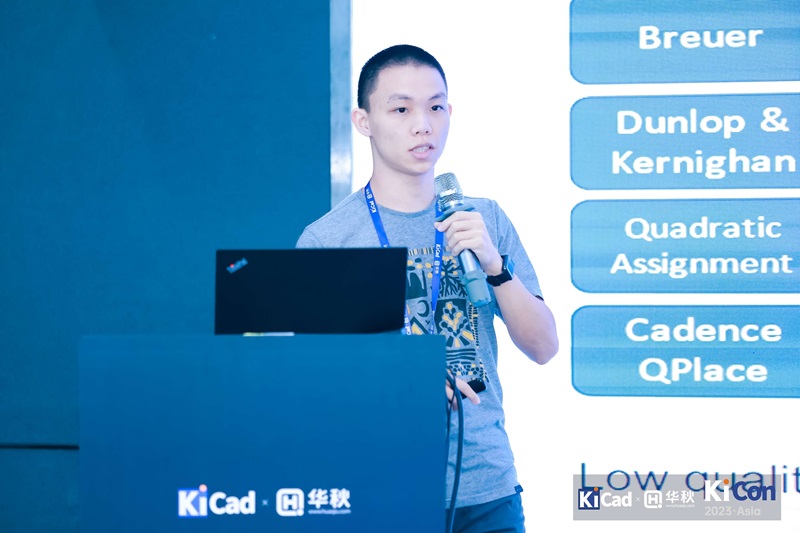
Two very different and advanced talks on the same topic by Zhang Jixin, teacher at the School of Computer Science at the Hubei University of Technology and the youngest KiCon speaker ever, undergraduate Zhu Yanzhen from the AI-EDA School of Integrated Circuits, Guangdong University of Technology.
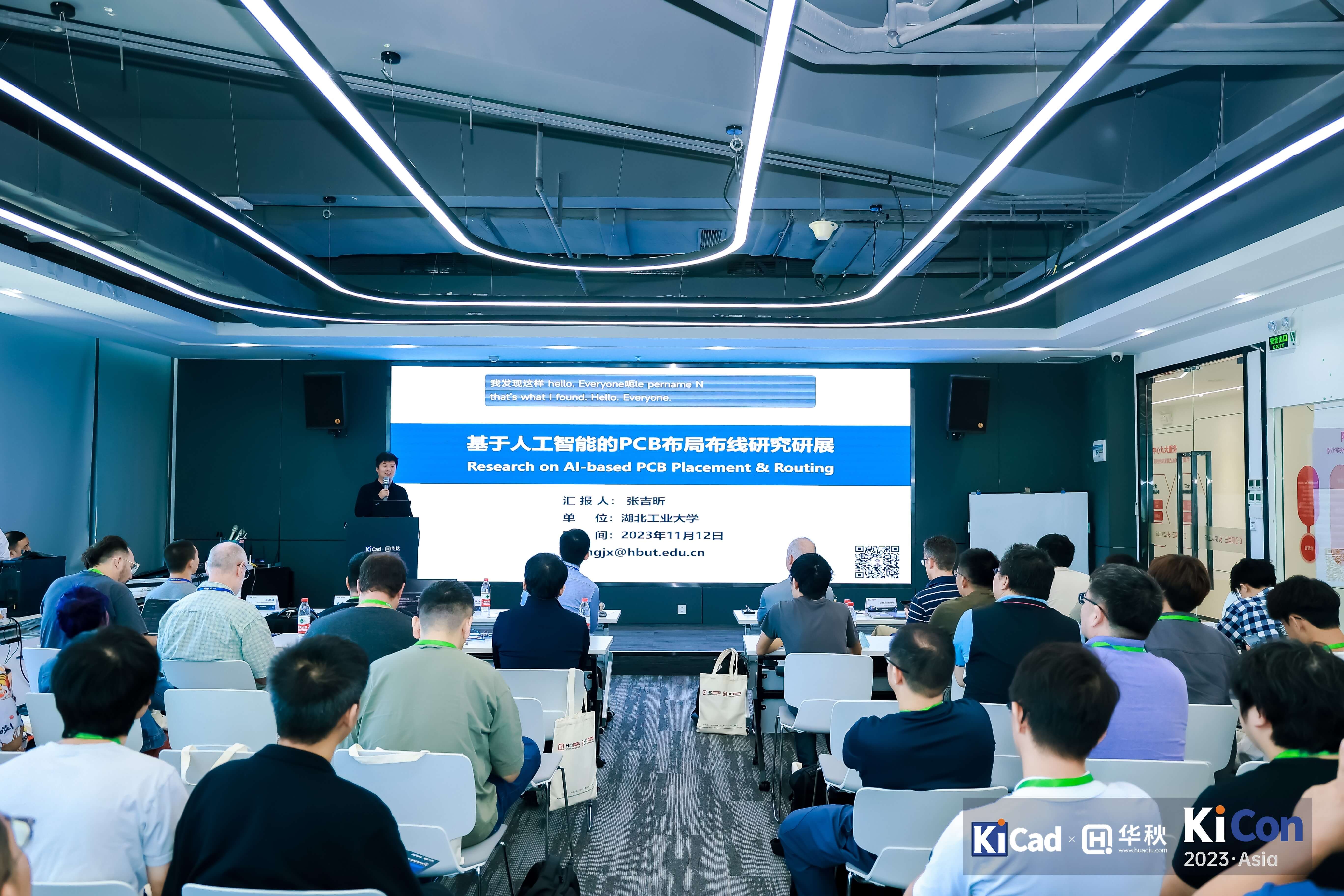
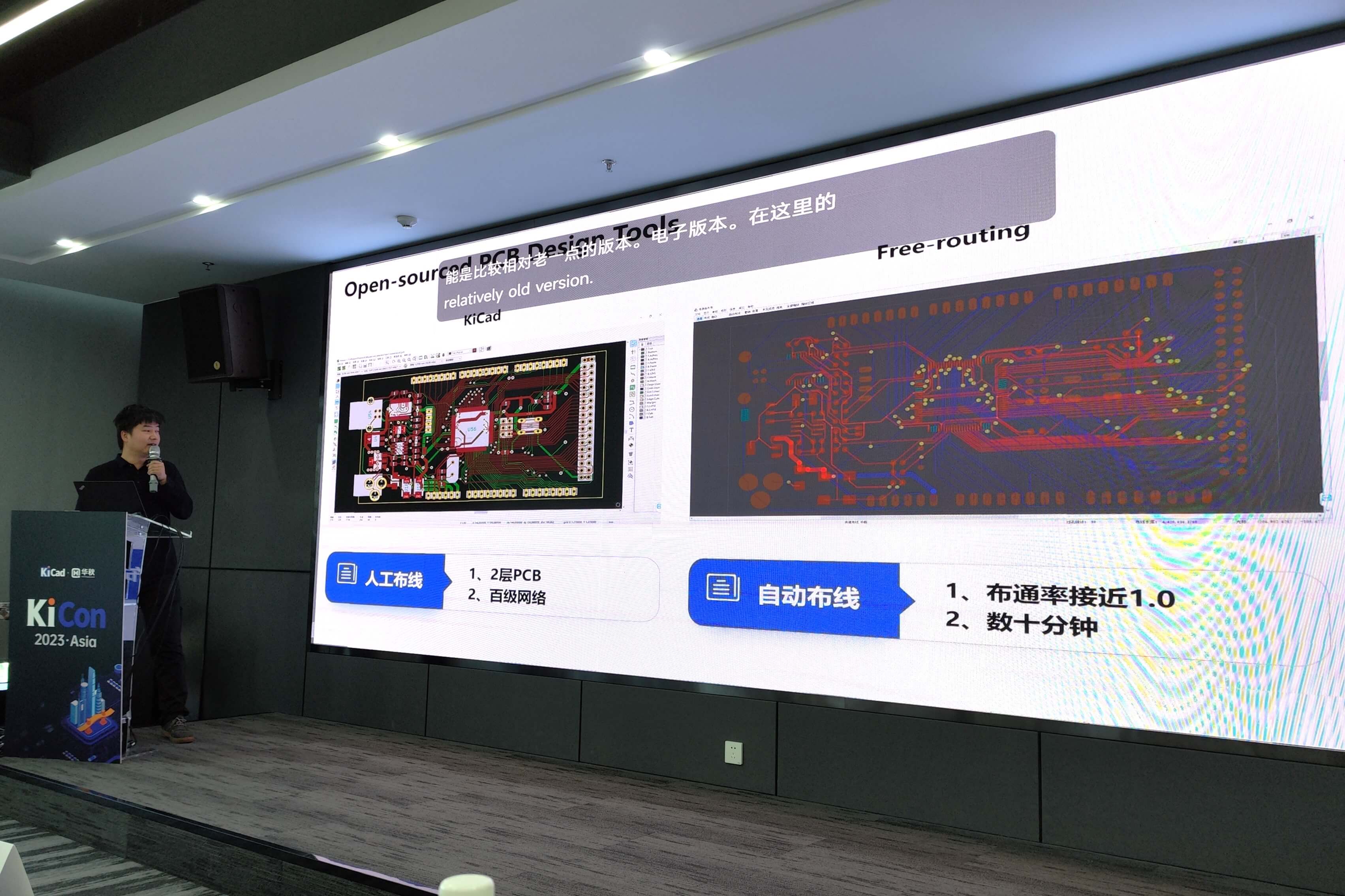
Jixin analyses the current state of AI-assisted auto-routing in EDA tools, something that KiCad has yet to explore. Could we see AI auto-routing come to KiCad? ‘Possibly’, says Jixin, and he would be willing to contribute on a personal level.
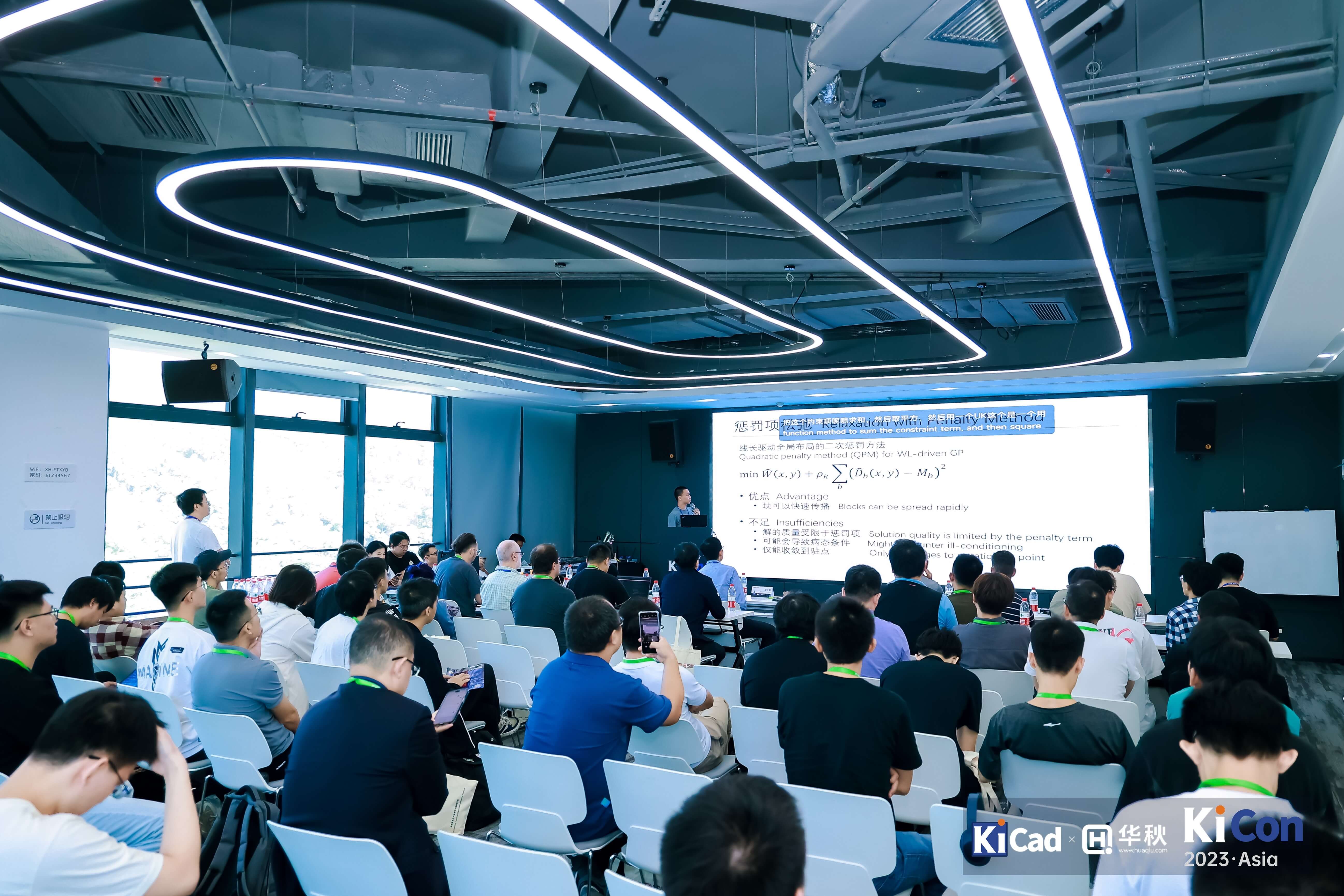
Yanzhen's research focuses on the auto-placement of IC chips using heuristic, analytical and machine-learning methods with congested constraints. His research hopes to resolve the difficulties in placing thousands of chips on complex designs while considering trace length, signal delay and electrical integrity for optimal performance.
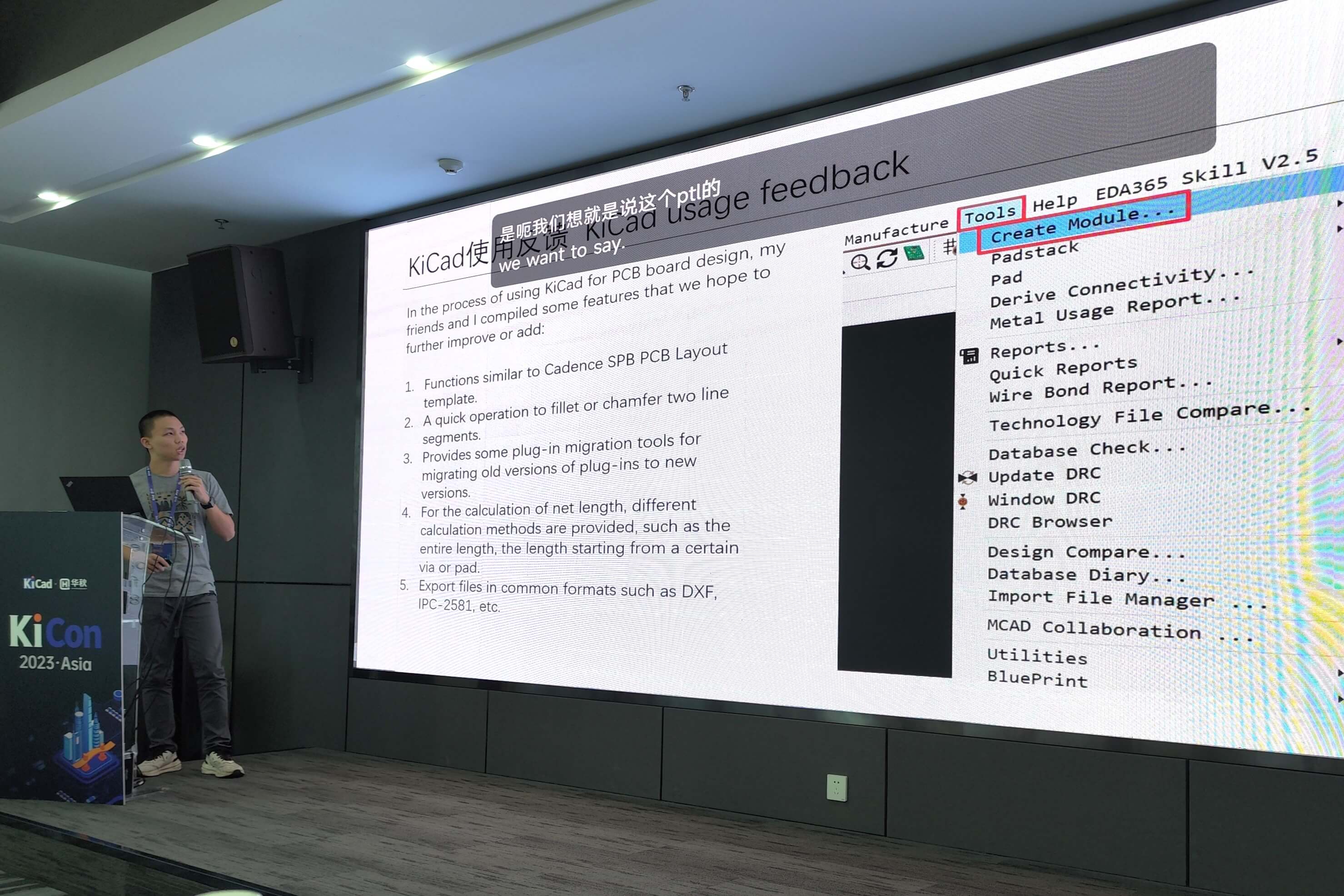
Following his experience using KiCad for research purposes, Yanzhen put the lead developers on the spot with his feedback.
by Huang Rui
Create flipchip and wirebonding packages with KiCad? Rui shared with the audience a fascinating application of KiCad to make flipchip and wirebonding packages for AIot chips, taking the KiCad lead developers by surprise.
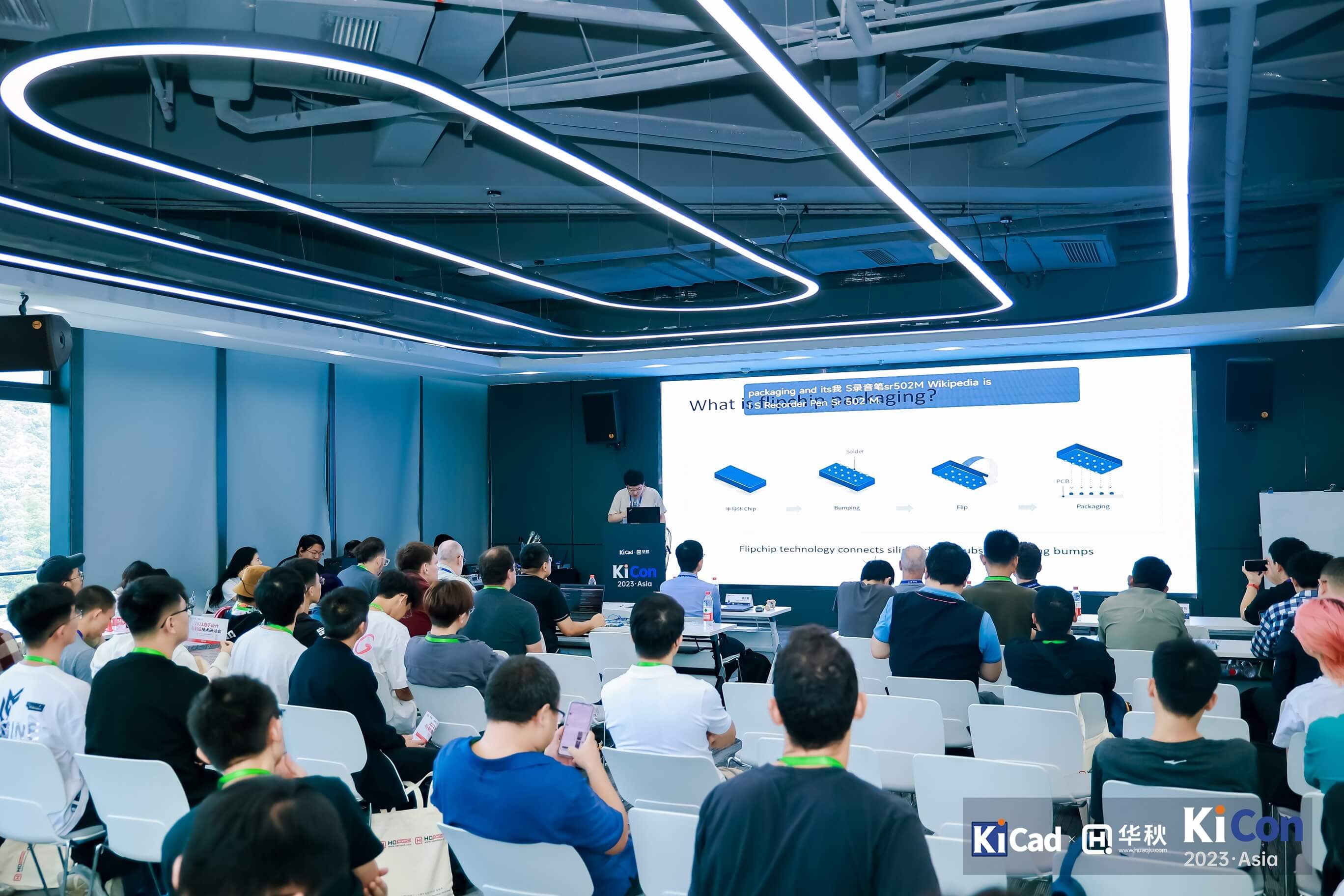
Despite English not being his native language, Rui was determined to power through his talk and impress us with his work.
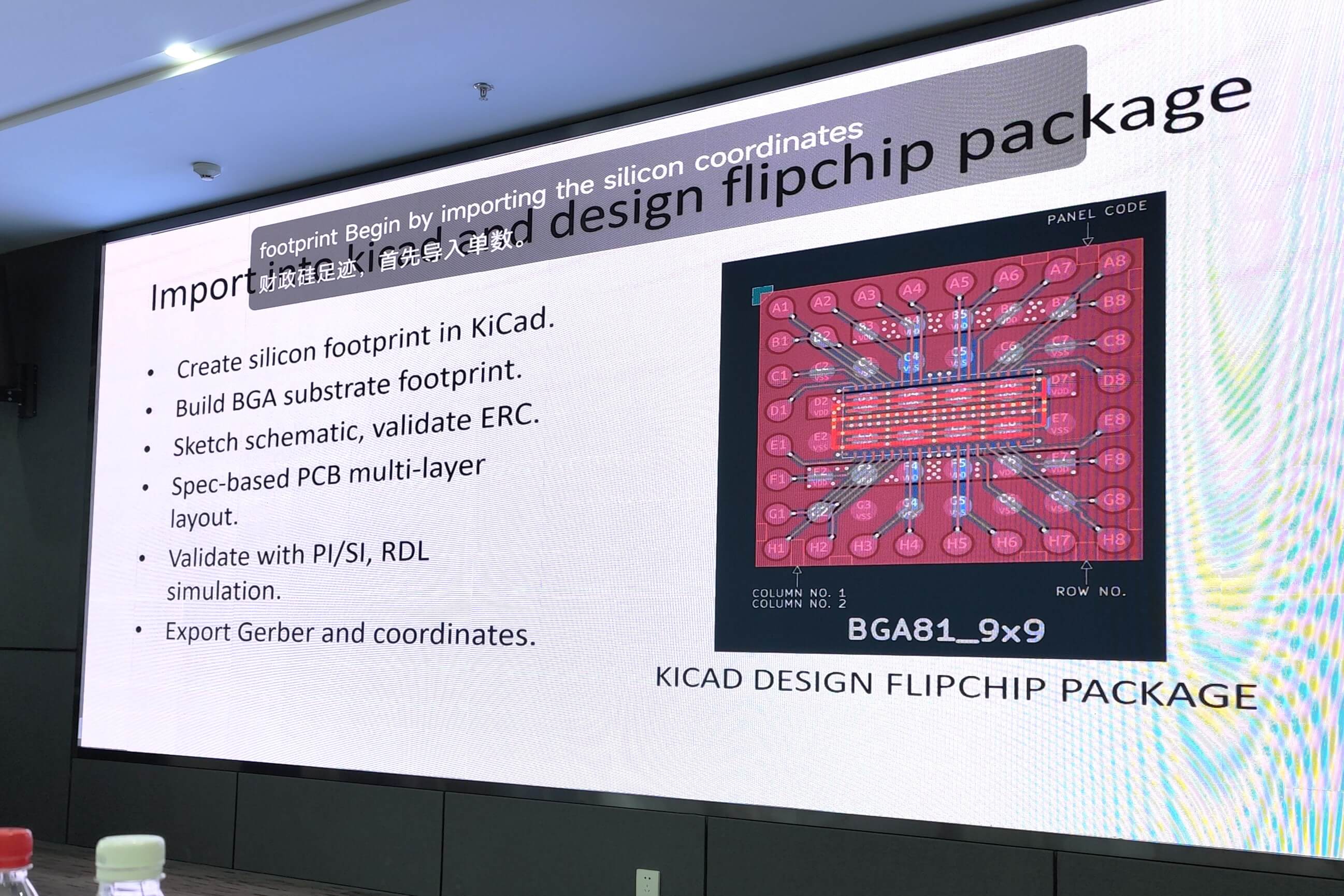
Rui used KiCad tools to create a larger version of the package footprint, verified it via simulation, and then miniaturized it to the size of the actual chip before sending it off for production.
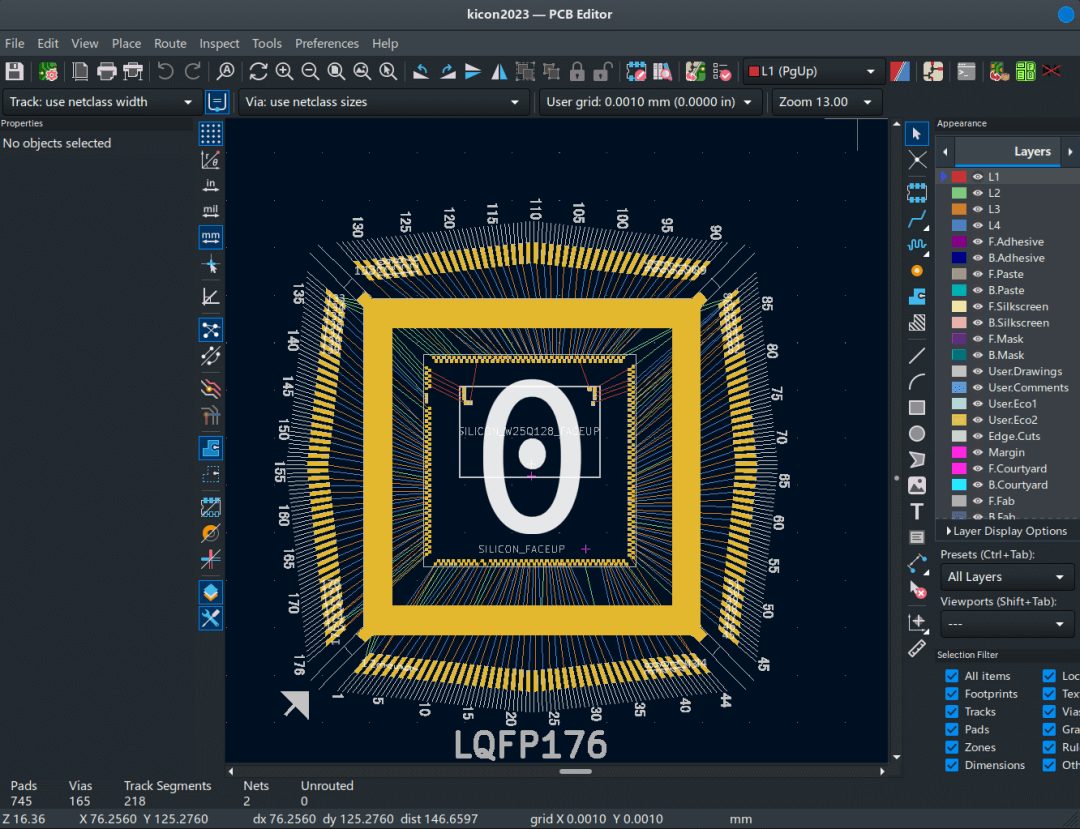
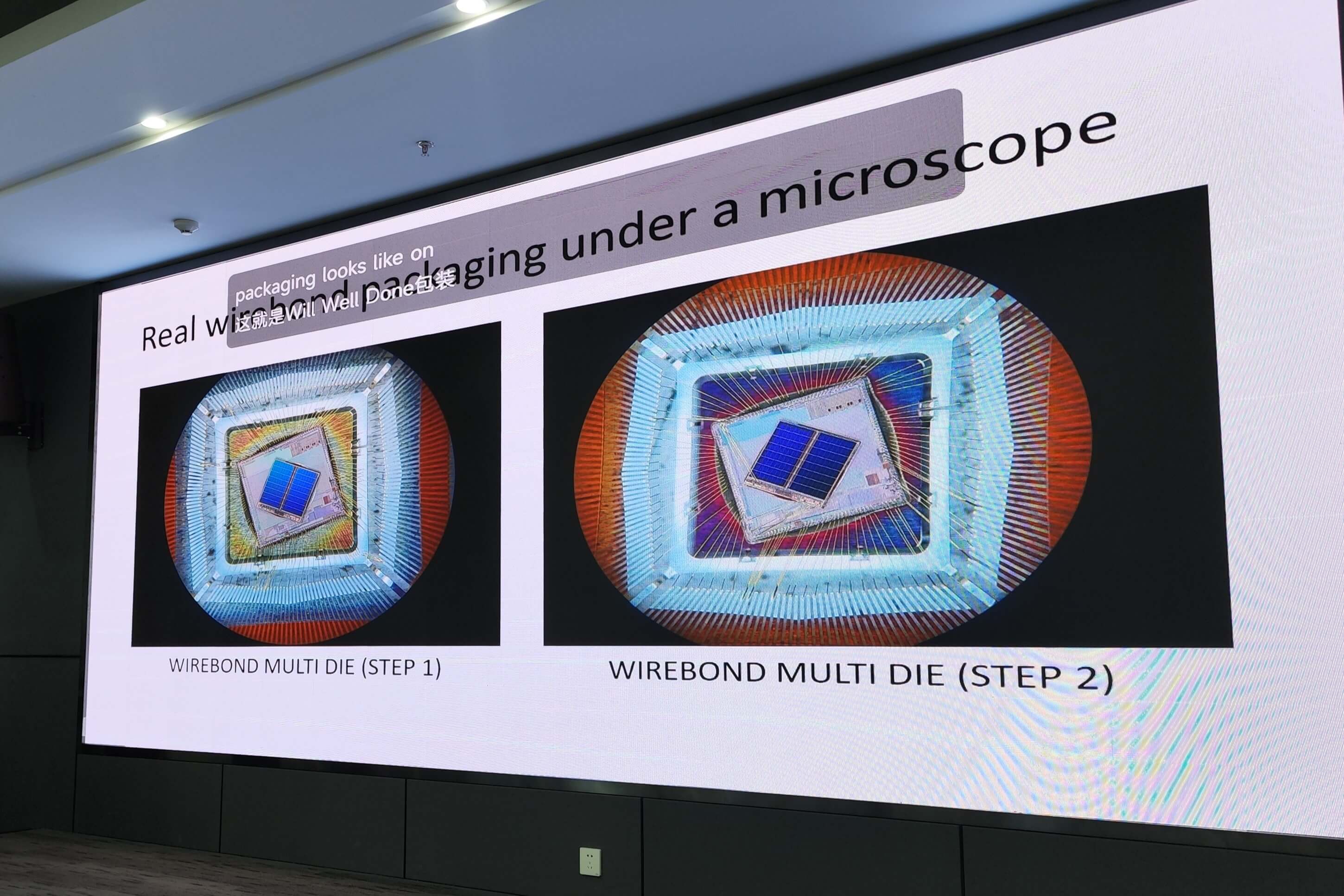
The results are spectacular
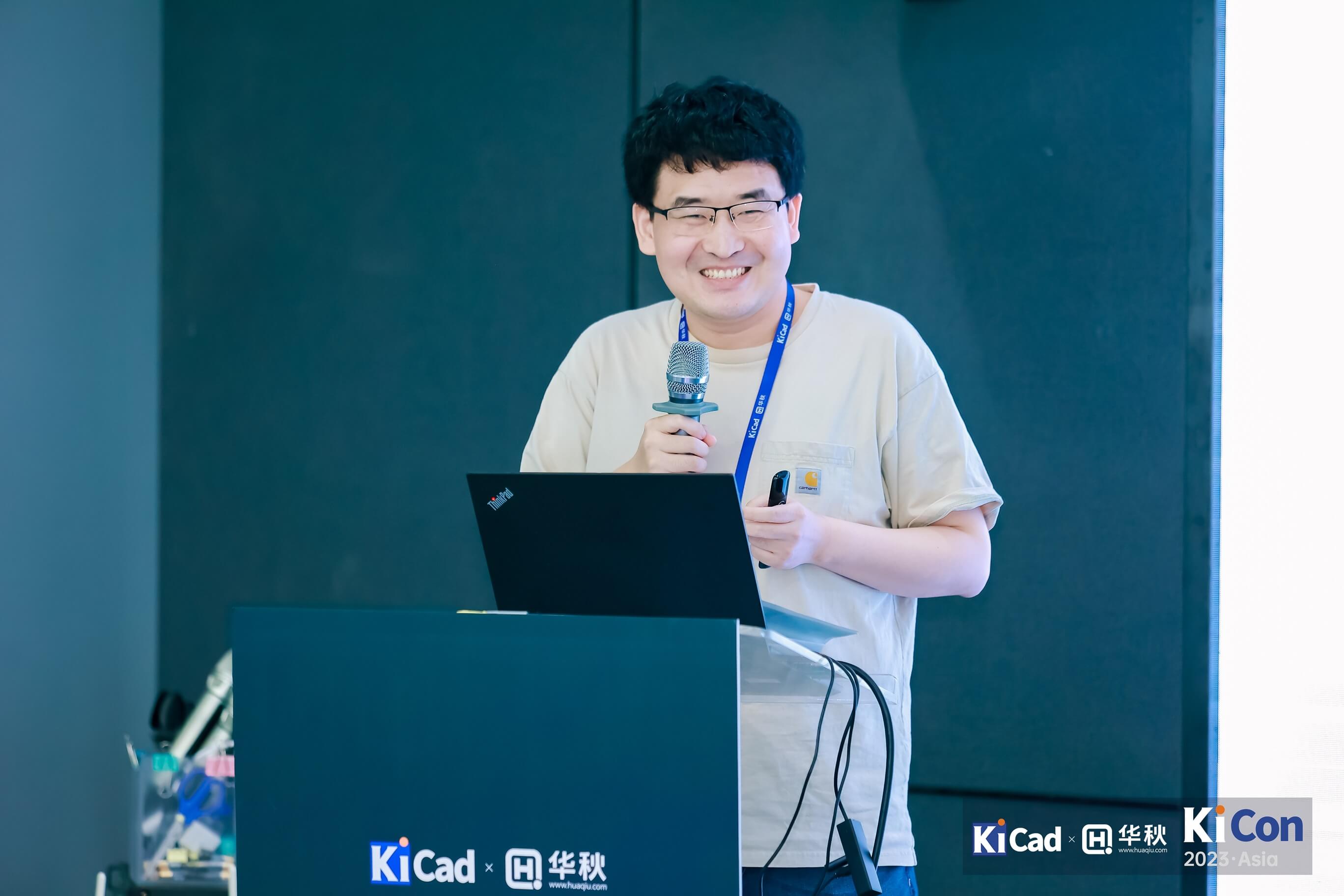
'Impressive work', commented Seth Hillbrand
by Seth Hillbrand
Seth is back with Custom Design Rules and how to make the most of KiCad’s customization options. Custom rules work alongside DRCs to help you control many aspects of your design.
This level of customization is very handy for team or shared projects to make sure the design complies with your precise requirements even if modified by someone else. For example, constraining trace width in specific areas, dealing with overlapping packages, and via-in-pads. For example, typically silkscreen is not printed on areas without solder mask. You can configure a custom rule to report an error when a logo overlaps a solder mask-free area.
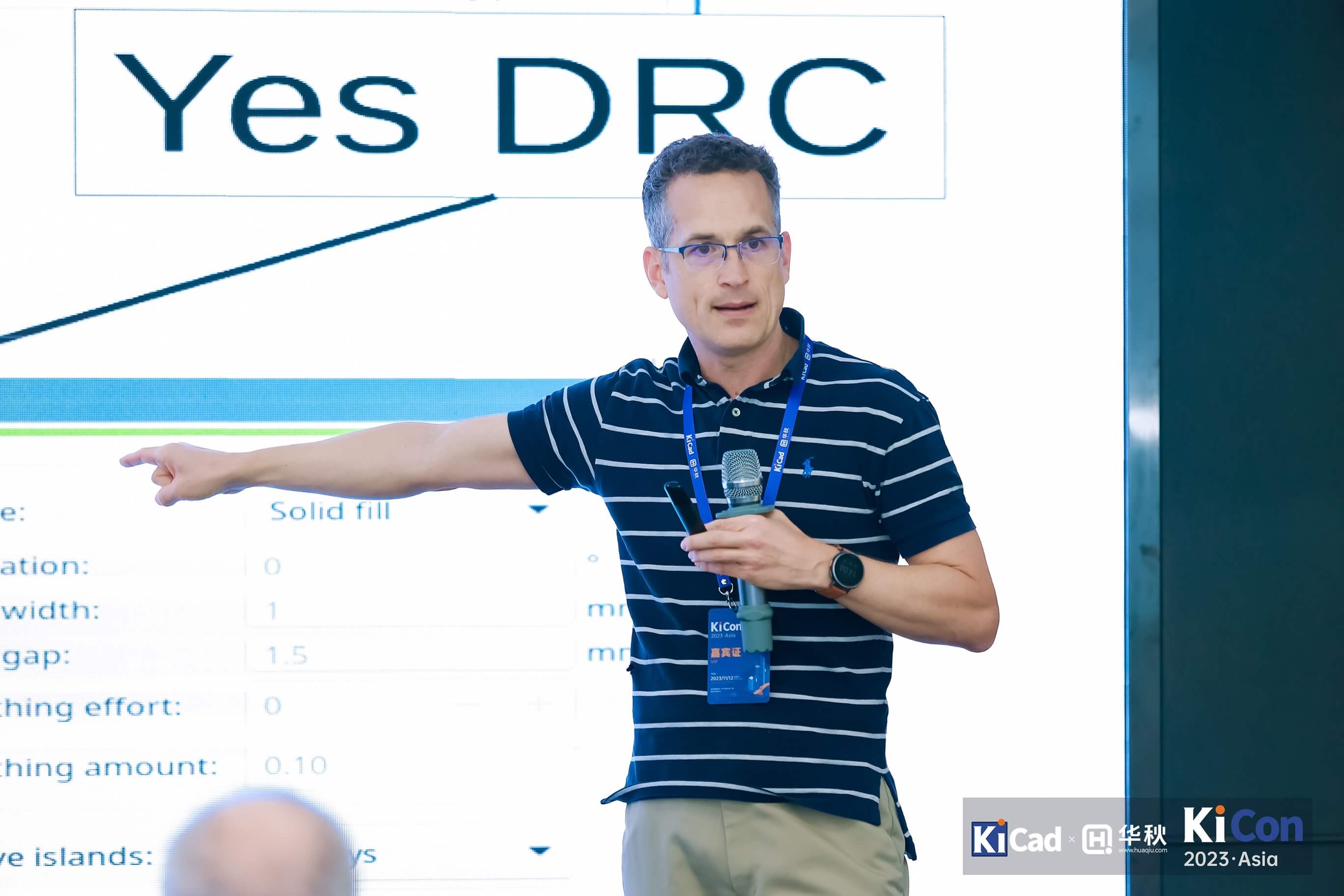
Yes DRC! No DRC!
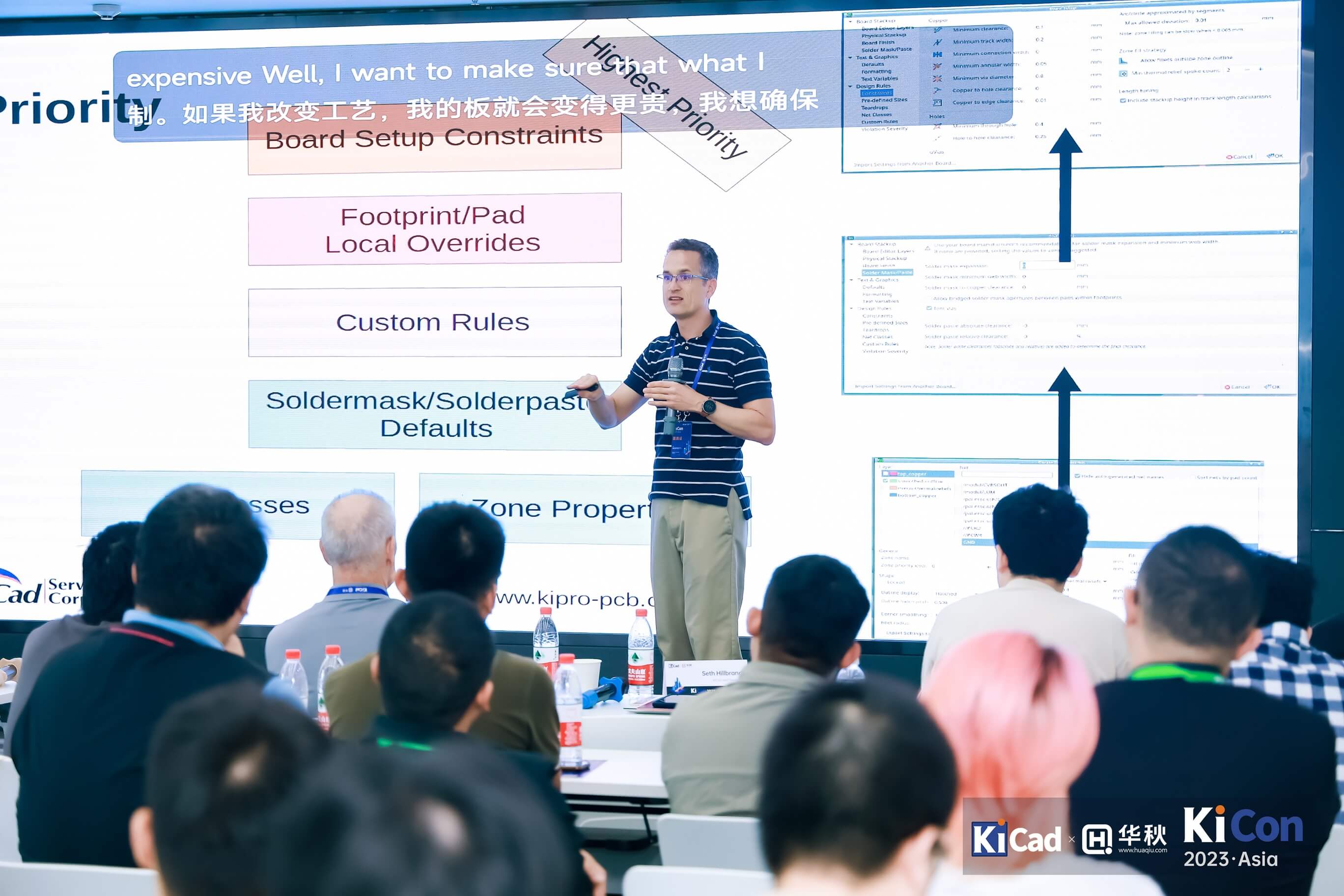
The all-important hierarchy of rules in KiCad.
by Zhuang Jiezhi
Zhuang Jiezhi from Huaqiu shares with us his experience working with KiCad developers and from developing various HQ KiCad plugins using Python.

Currently, Python plugins can only be written for the PCB editor which is generated by the Simplified Wrapper and Interface Generator, or SWIG. Since this interface is a binding layer and not a true API, there are stability issues across KiCad versions. Submitting a new plugin to the KiCad repository requires debugging and packaging the plugin then submitting it to the official KiCad repository before submitting the package.

In his talk, Jiezhi revealed a new DFM plugin for KiCad in addition to the latest HQ NextPCB agile manufacturing plugin. The new plugin essentially brings HQDFM’s advanced DFM analysis to KiCad, including click-to-view and detailed descriptions and suggestions. He and his team are also working on another plugin to help create the BOM.
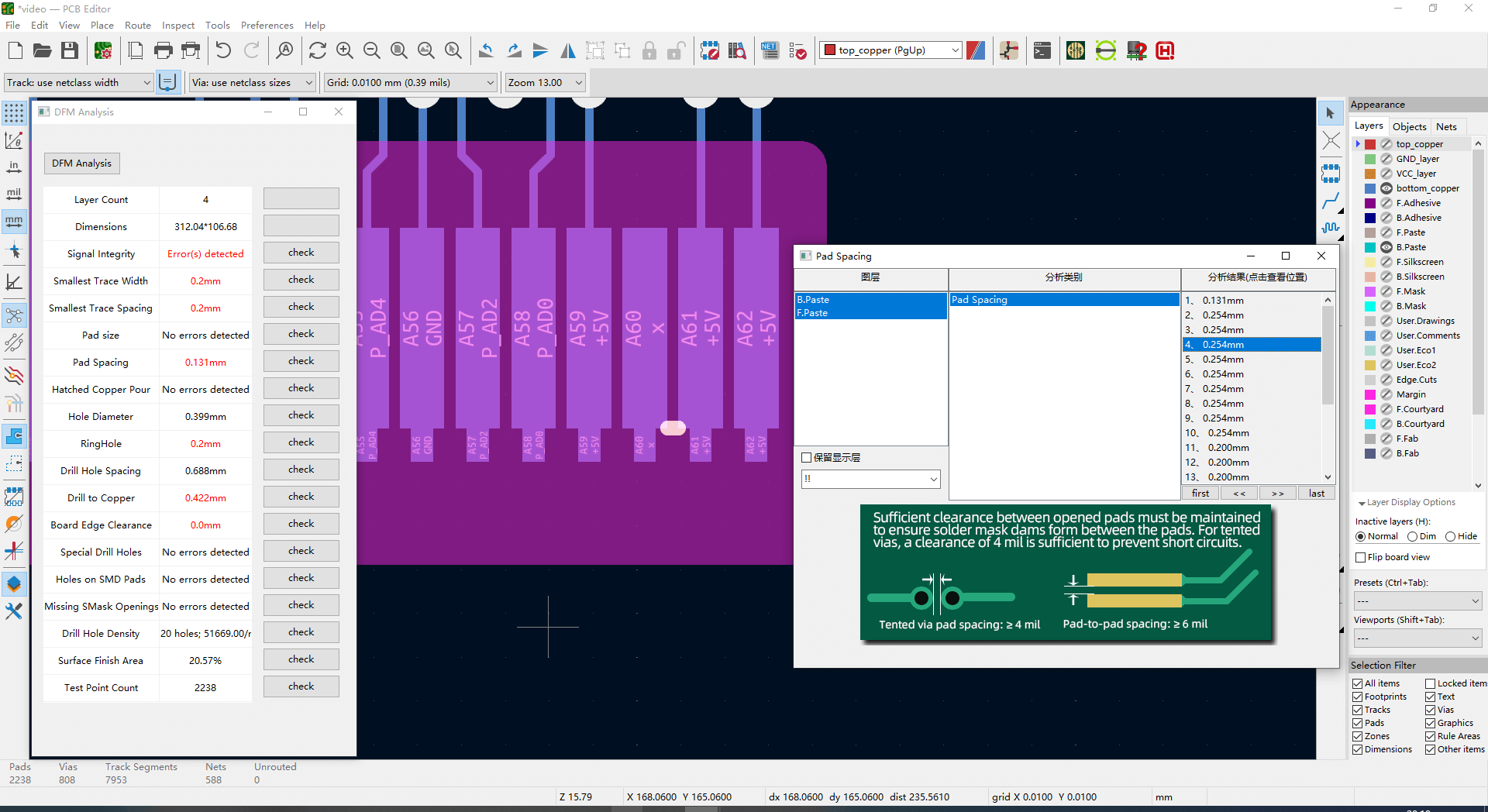
The DFM plugin will be available in KiCad soon.
by Carmen Zheng
For the last talk of the day, Carmen Zheng from Huaqiu’s overseas division (HQ NextPCB) talks about DFM and highlights why it is important to perform DFM checks in addition to Design Rule Checks and custom rules. Problems arise when designers lack manufacturing knowledge and experience, lack good communication with manufacturers (especially for overseas manufacturers), or lack the tools to effectively perform DFM checks.
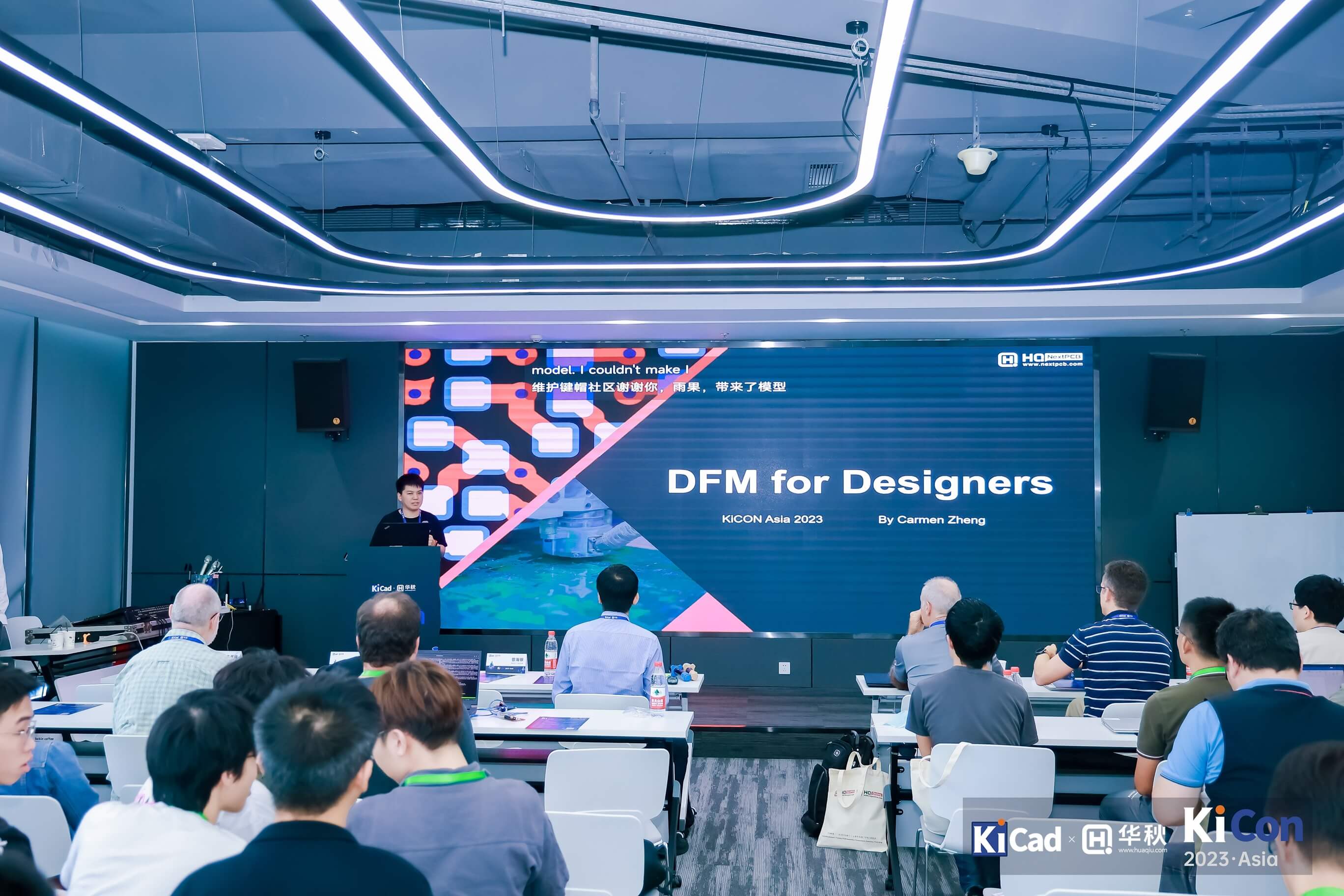
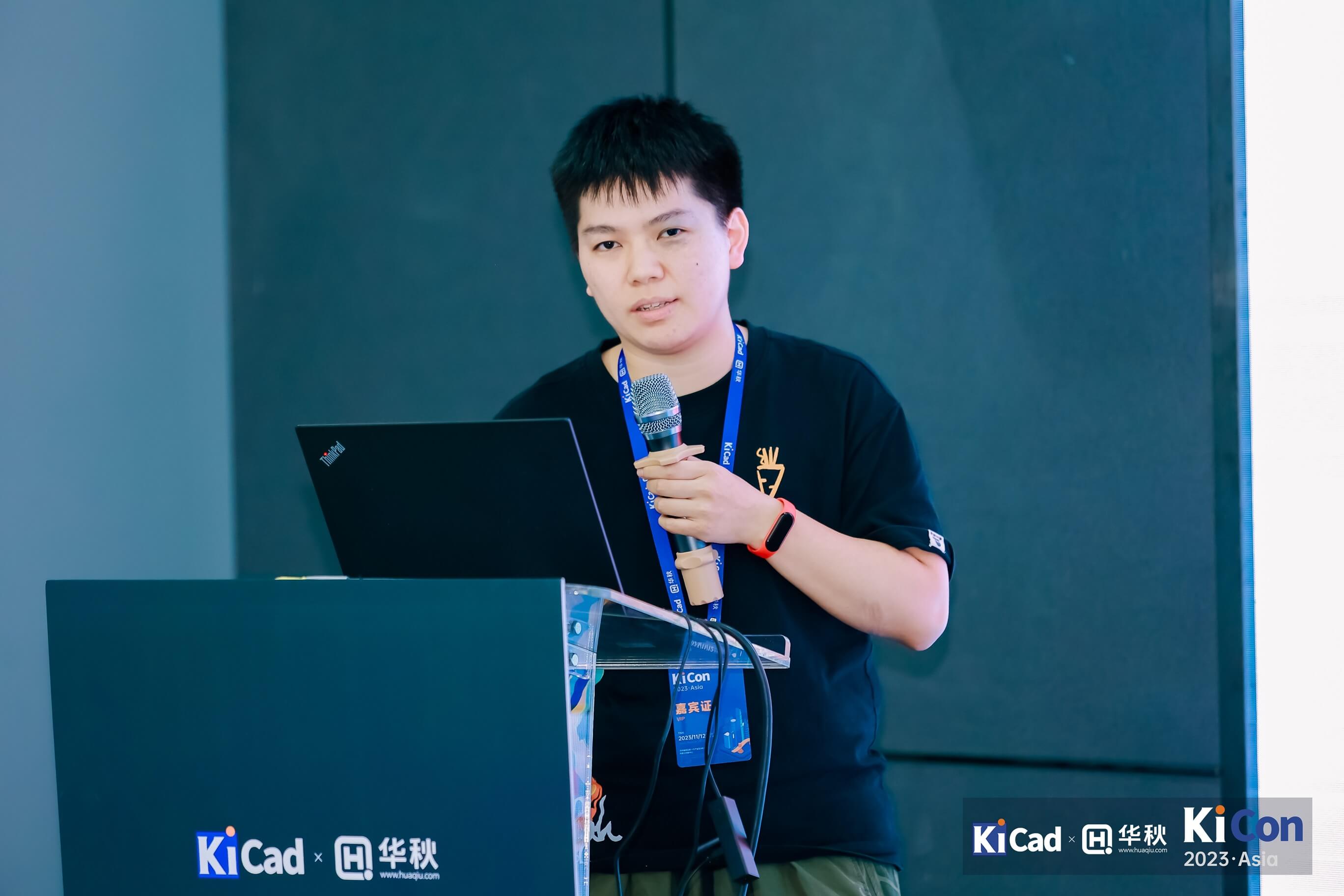
Carmen, who designed the DFM RuleR in KiCad, expands on some of the DFM checks performed by HQDFM and the KiCad plugin. And talks more about the checks typically not caught by DRCs using the rules on the ruler as a visual guide.
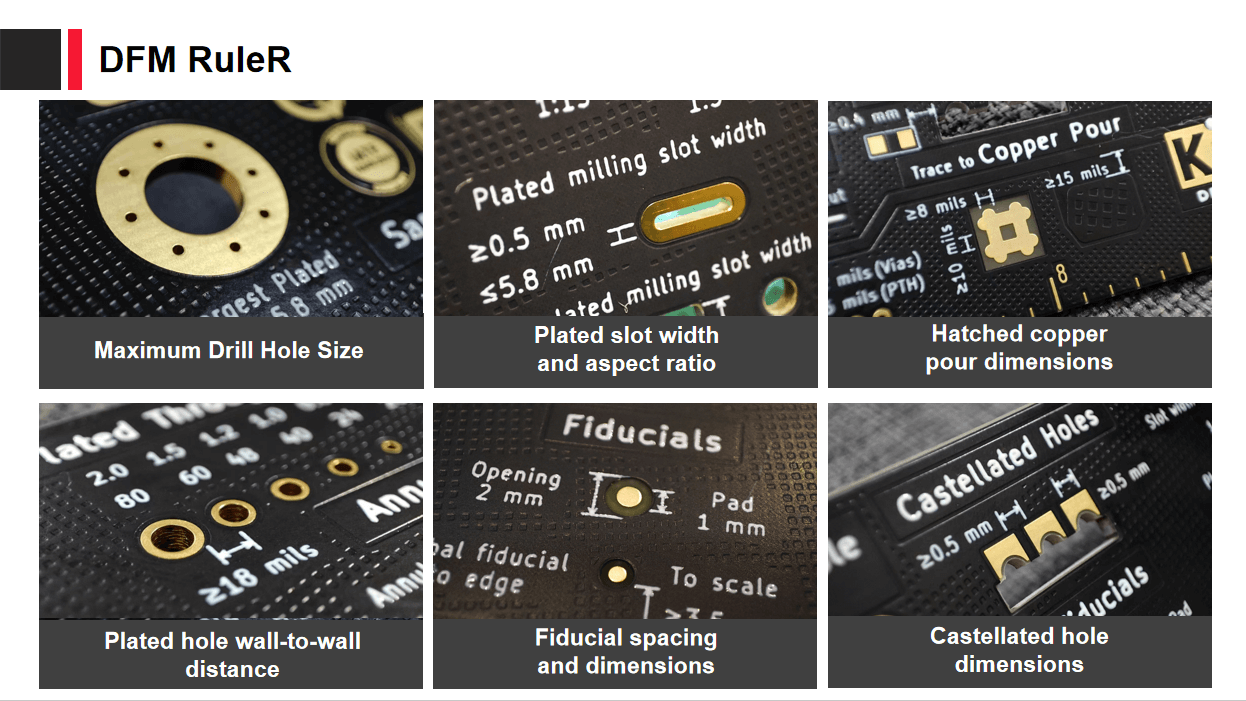
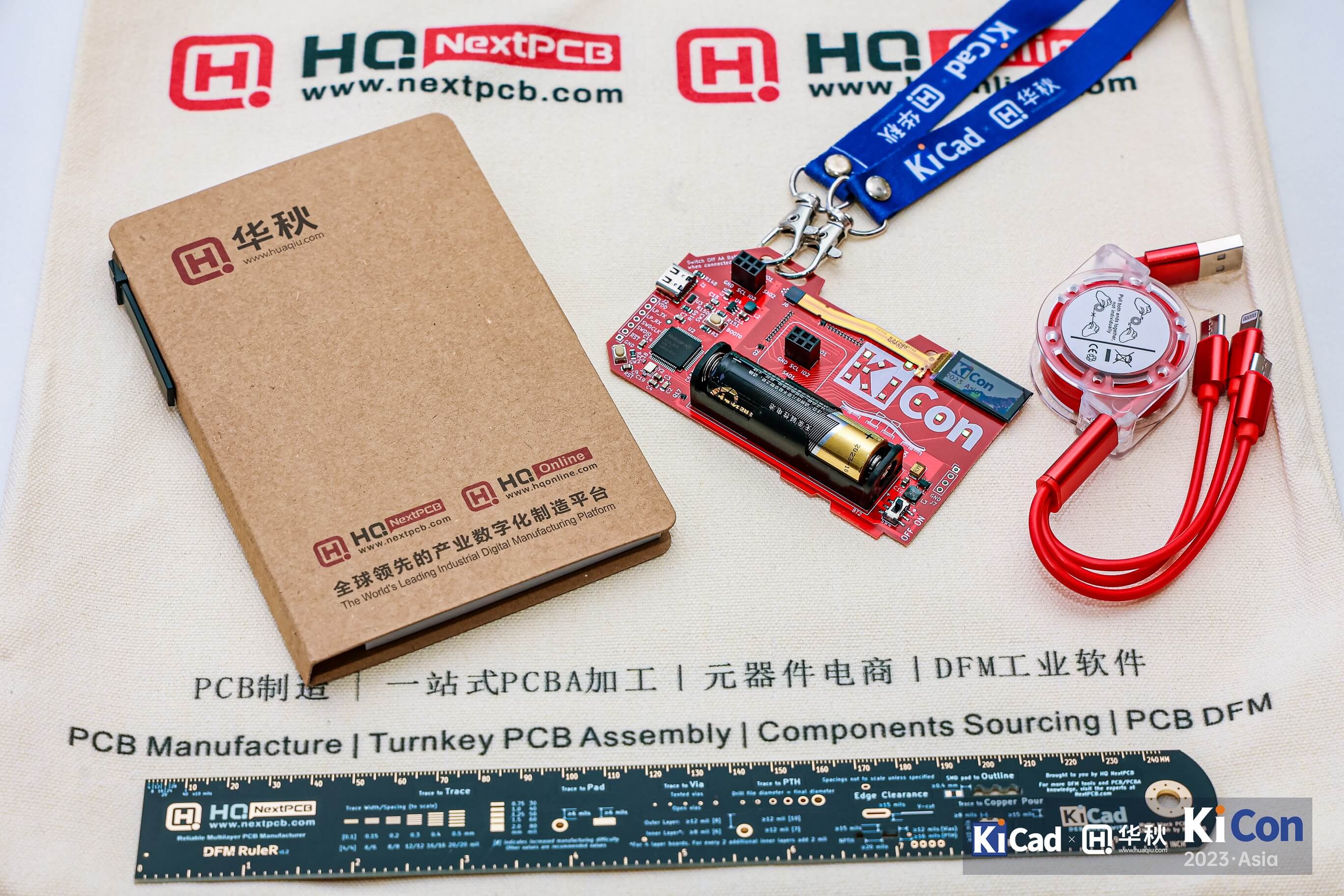
All KiCon Asia participants received a tote goody bag from Huaqiu with the KiCon SAO Badge, DFM RuleR and more.
by Hubert Hu

In a talk comprising of a single slide, Hubert Hu of Huaqiu Electronics who served as host for the day, quickly summarized the EDA formats KiCad 7 and KiCad 8 supports. Hubert Hu is the main coordinator for the day’s event, organizing everything in less than 2 months, after being inspired at KiCon Europe. Hubert and his team actively support KiCad development and promote KiCad with China with summits, community activities and publicity. In addition to the current plugins, Huaqiu hopes to simplify the procession from design to product through practical means.
KiCon is not KiCon without a Q&A session. KiCad lead developers Wayne and Seth were bombarded with questions ranging from integrations with third-party footprint suppliers and 3D CAD software, repository version control, file format changes and offerings of help from the Chinese KiCad community.
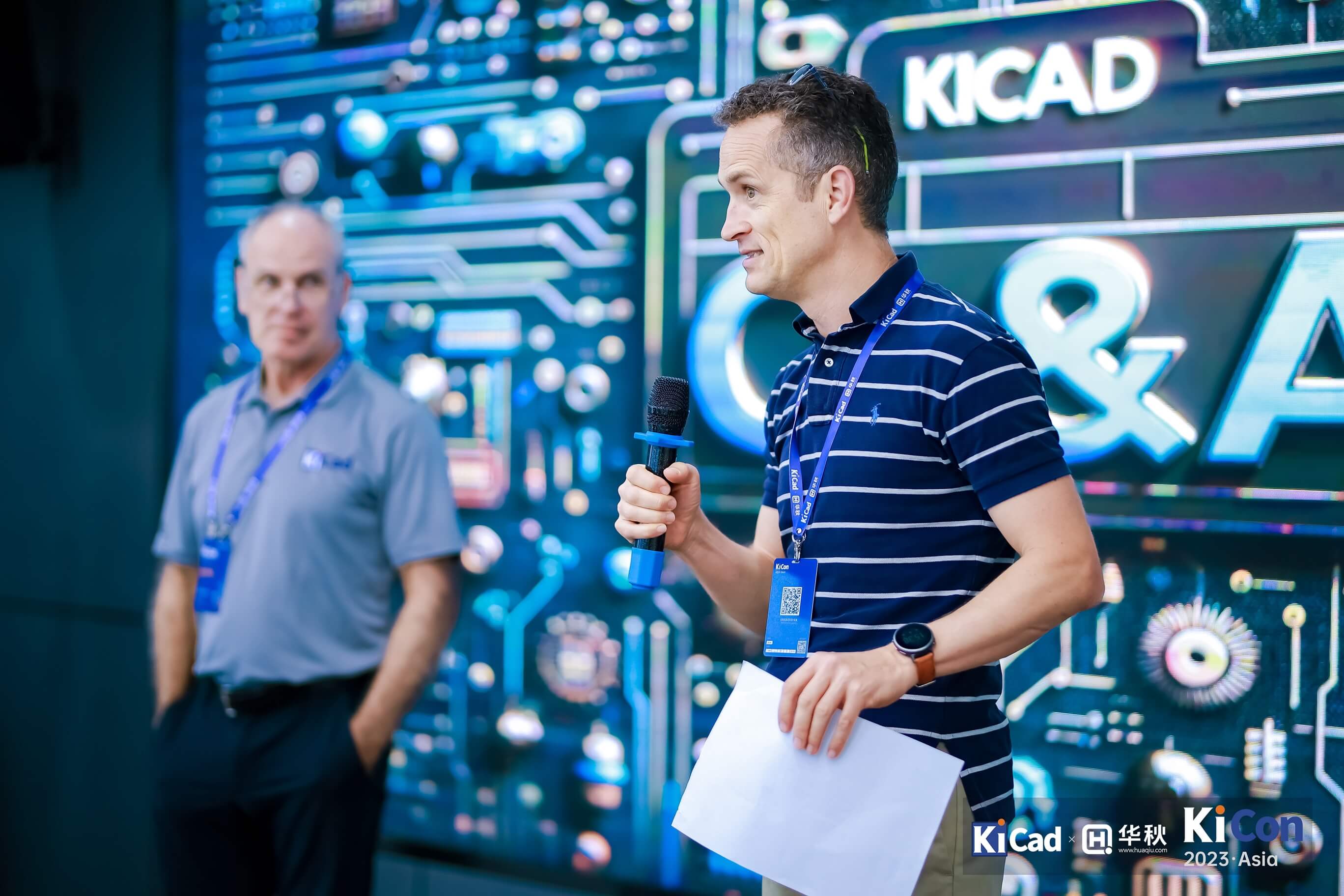
The background graphic was created using AI, hence the odd objects and connections.
by Paul Hamilton
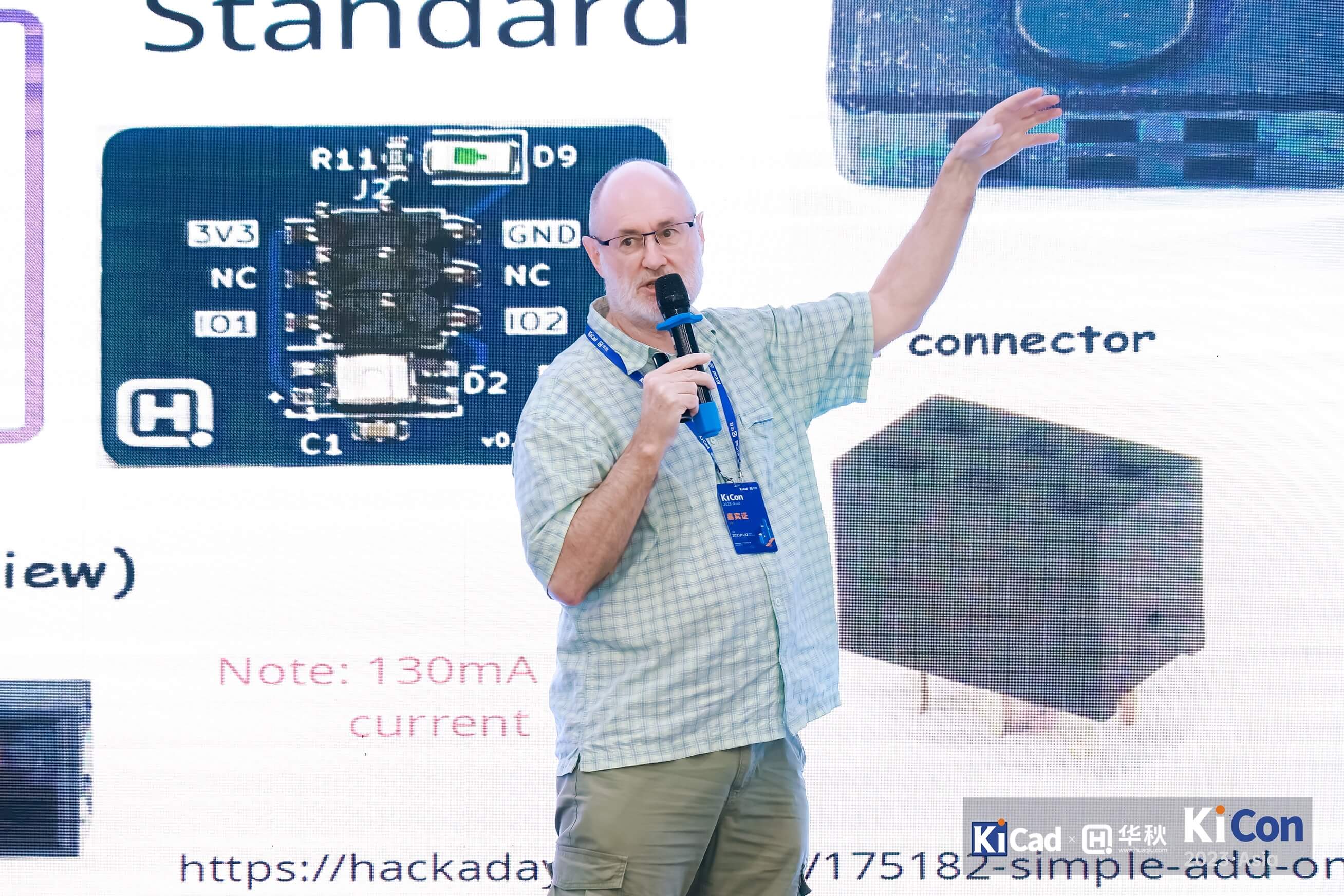
To complement the KiCon SAO badge, Paul held an SAO hat surface mount soldering workshop using homemade laser-printed stencils, mini hotplates, parts fresh from Huaqiangbei and chopsticks (!).
Let's hope we'll see SAO hat designs from the Chinese KiCad community at KiCon 2024!
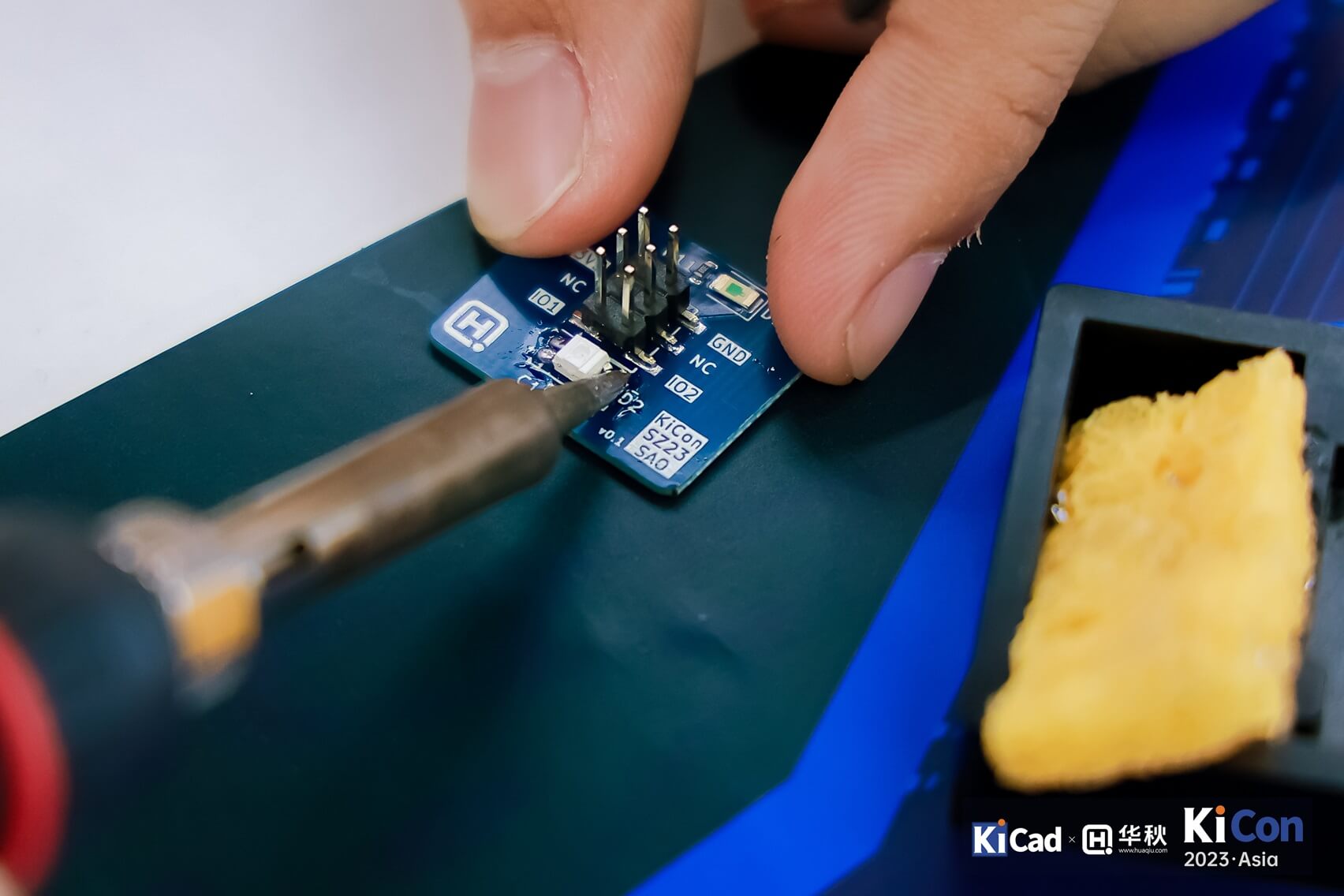
Eager to dive in, electrical engineers use whatever tools are available.
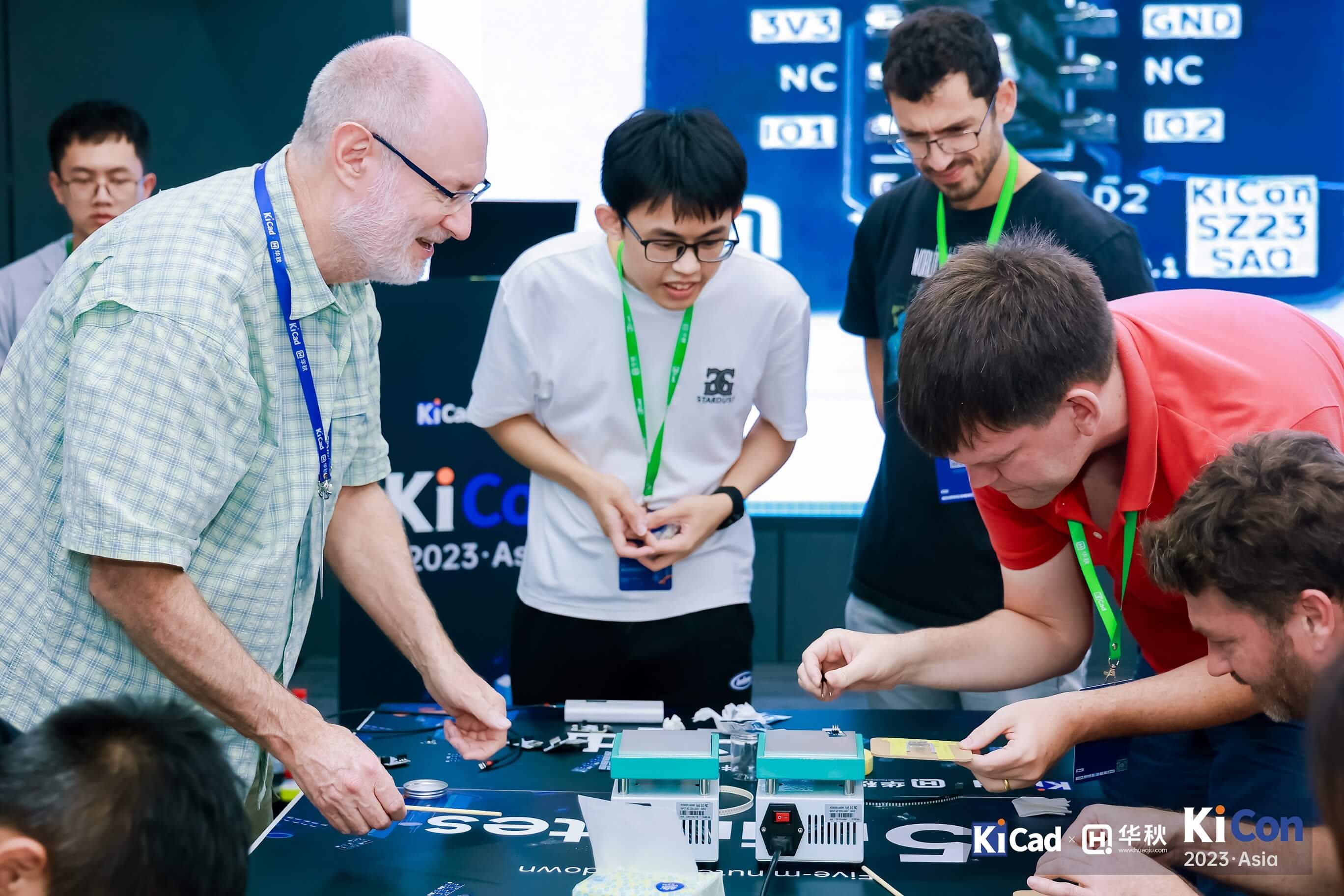
Waiting for the magic to happen
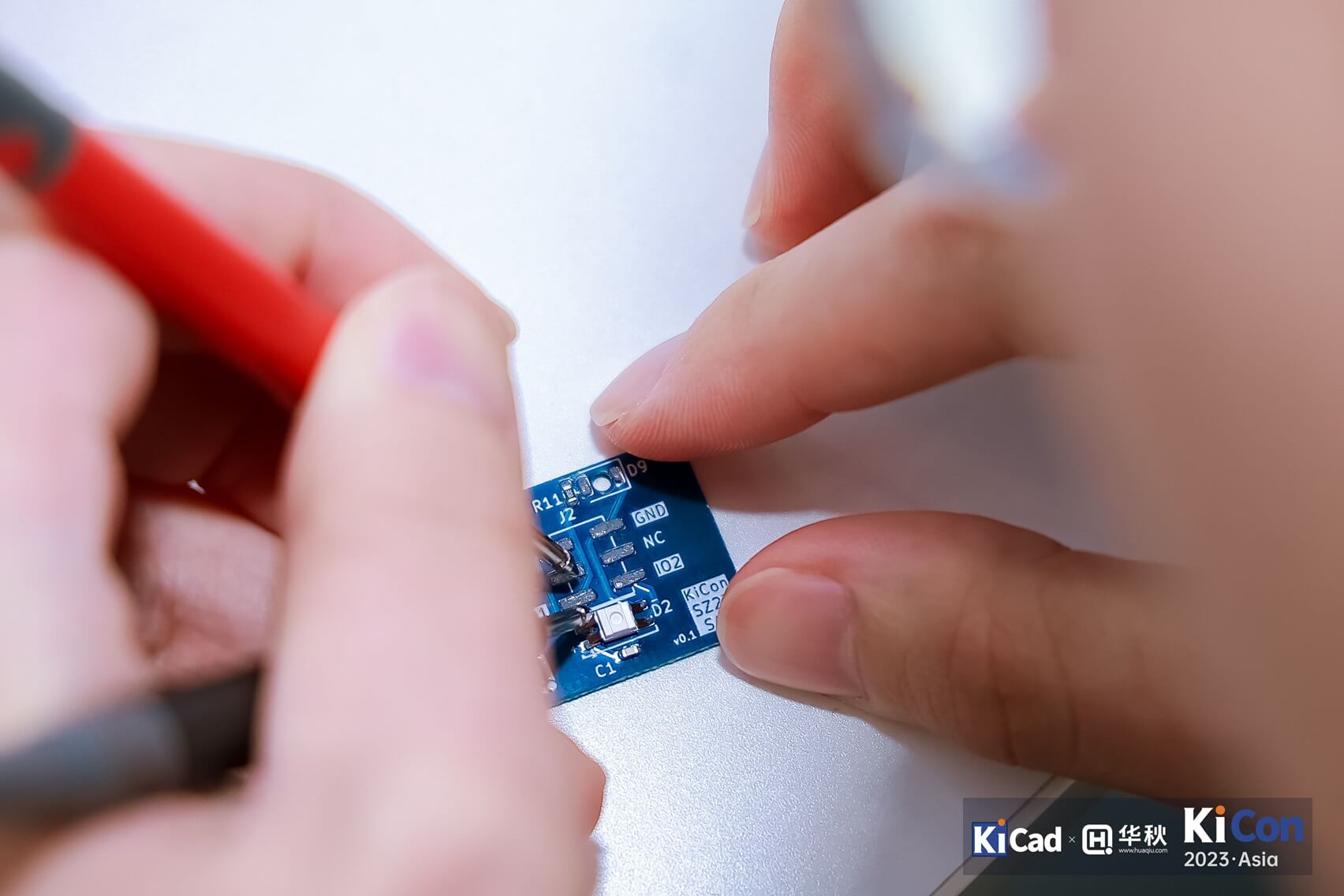
No tweezers? No problem, just use test probes.
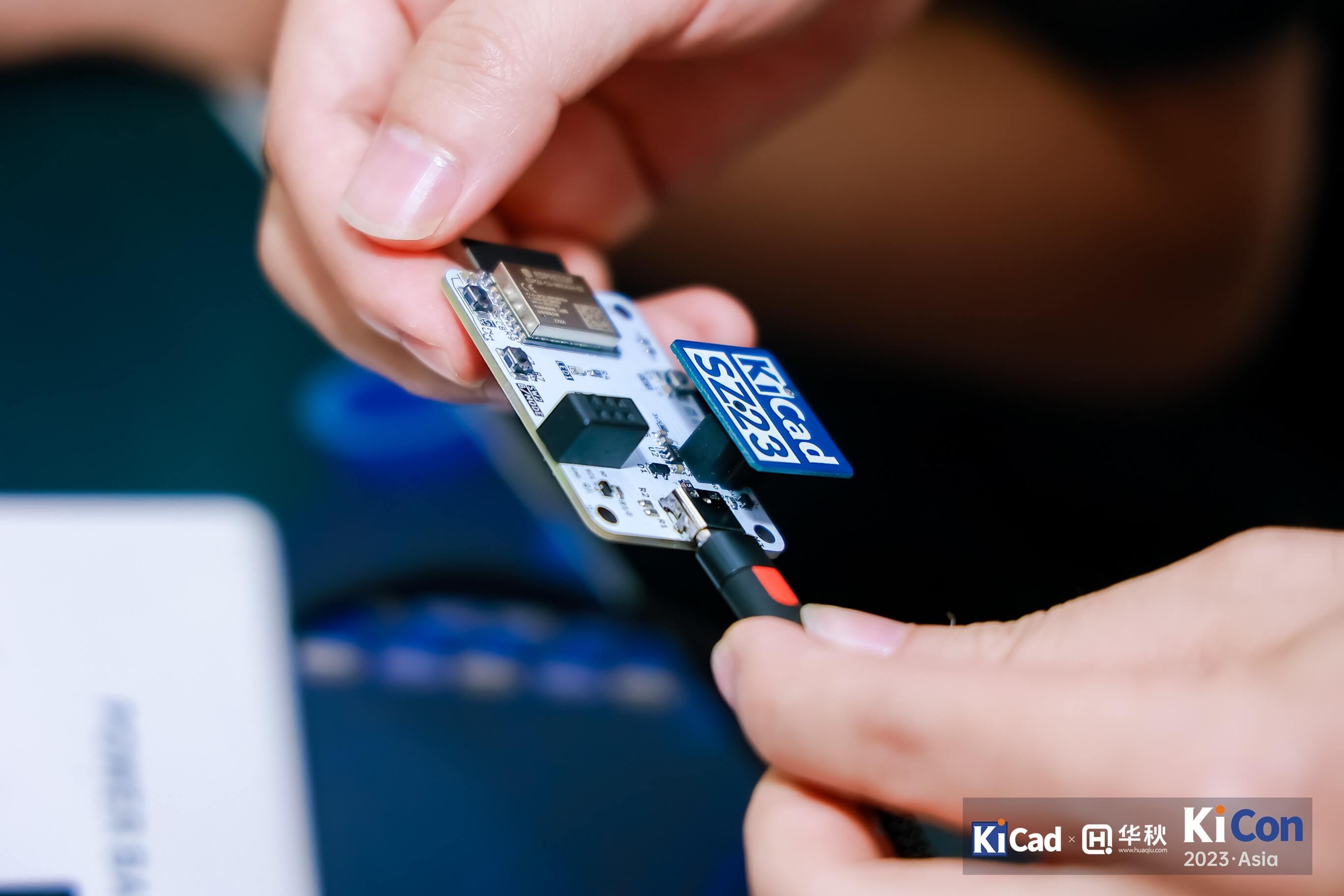
Testing the hat with a board designed by Paul.
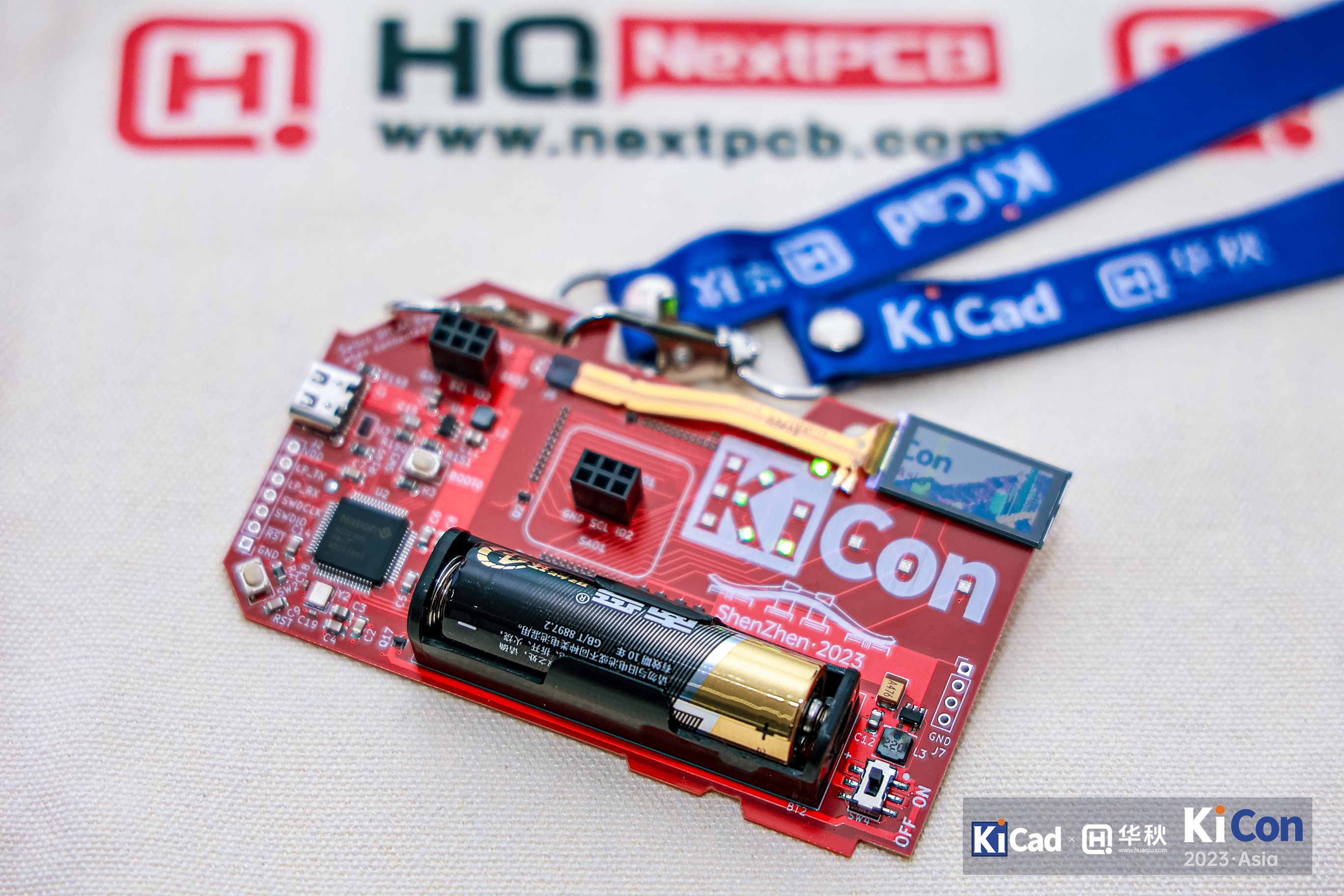
The KiCon SAO badge has ports for two SAO hats.
In an exclusive interview, Seth summarizes the day and answers questions on KiCad’s development internationally, the challenges of being open sourced and what he hopes for the future between KiCad and Huaqiu.
We also had the privilege of getting some insider talk from Wayne (while traveling from the airport). Wayne spoke of the difficulties working with the Python API and binders for the plugins and plans to get rid of it to maintain KiCad stability (developers will have to update their packages). He also mentioned that working on KiCad is a seven-day job and previously when he only worked on KiCad part-time, he would have to take holidays to go to conventions which annoyed the misses, and that any 'day off' would mean his inbox gets filled with emails and pull requests. While both Seth and Wayne speak tentatively about competitors, what really sets KiCad apart from other EDA tools is the open-source nature; the importance of contributors and listening to requests, and their openness towards criticism.
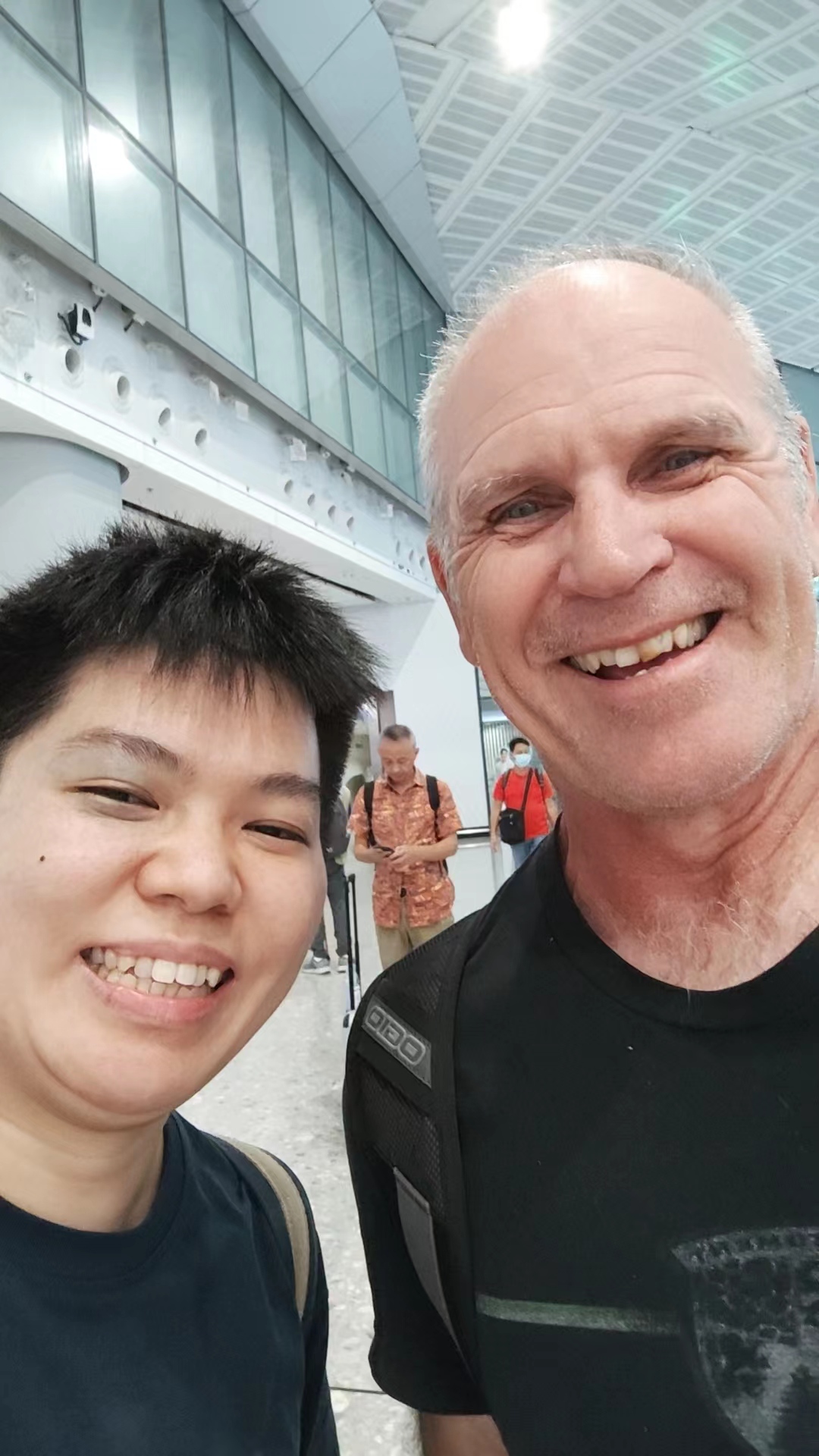
Look what I picked up at the airport
Wayne also mentioned how he used to travel occasionally to Shenzhen on business when visas and regulations were more relaxed and he has witnessed how much Shenzhen has developed in such a short space of time. He even brought cash from his last visit. Meanwhile, Seth had done his homework and came prepared with a Chinese SIM and WeChat account and was paying via QR code like a local.
Special thanks to Wayne and Seth for their hard work and bringing KiCon to the east, Hubert and the HQ team for orchestrating and making all the preparations, Paul for his wonderful workshop, Hawk for designing the SAO badge, all the speakers for sharing their unique experience and knowledge, the audience for their enthusiastic support and the entire KiCad community for making KiCad what it is today.
Everyone’s contribution made this KiCon possible. Let’s hope it is the first of many!
Shenzhen Huaqiu Electronics Co. Ltd., The World's Leading Industrial Digital Manufacturing Platform, has served national engineers in Mainland China for over 15 years, becoming a household name in providing full-feature multilayer PCBs engineers can trust.
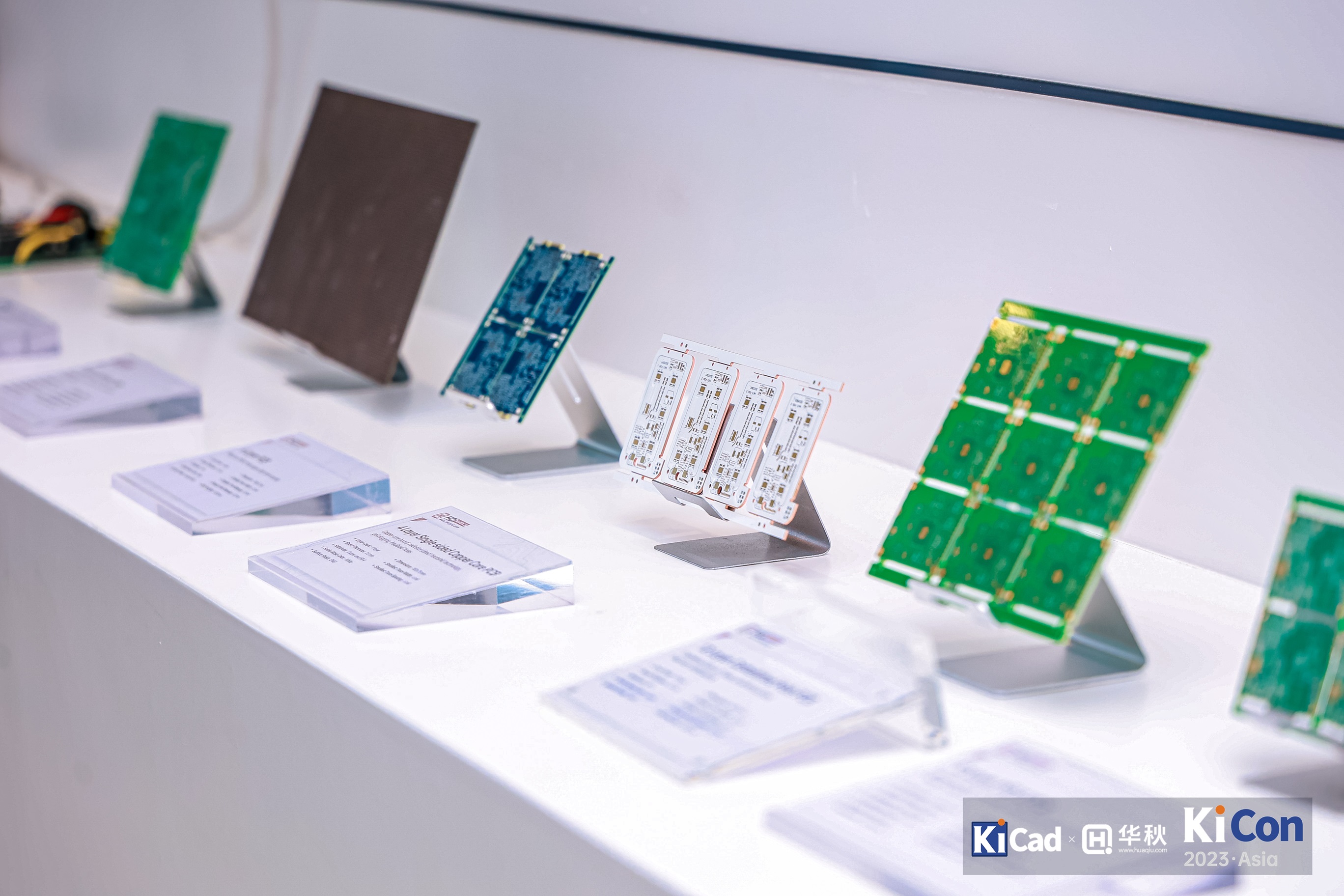
HQ NextPCB and HQ Online are the overseas trading brands of Shenzhen Huaqiu Electronics Co. Ltd., and bring HQ's capabilities, speed, affordability and more, to international customers, skipping the middleman and providing the same intelligent online quotation system from the industry’s experts.
Huaqiu Electronics believes innovation is key to maintaining excellence, which has motivated them to transform the electronics manufacturing industry. Huaqiu’s in-house engineers developed the free Design for Manufacturing software, HQDFM, revolutionizing how PCB designers visualize and verify their designs. HQ also actively supports the open-source EDA software suite KiCad with custom plugins and feature requests, and by nurturing the Chinese KiCad community.
Still, need help? Contact Us: support@nextpcb.com
Need a PCB or PCBA quote? Quote now
|
Dimensions: (mm) |
|
|
Quantity: (pcs) |
|
|
Layers: 2 |
Thickness: 1.6 mm |
|
|
|